
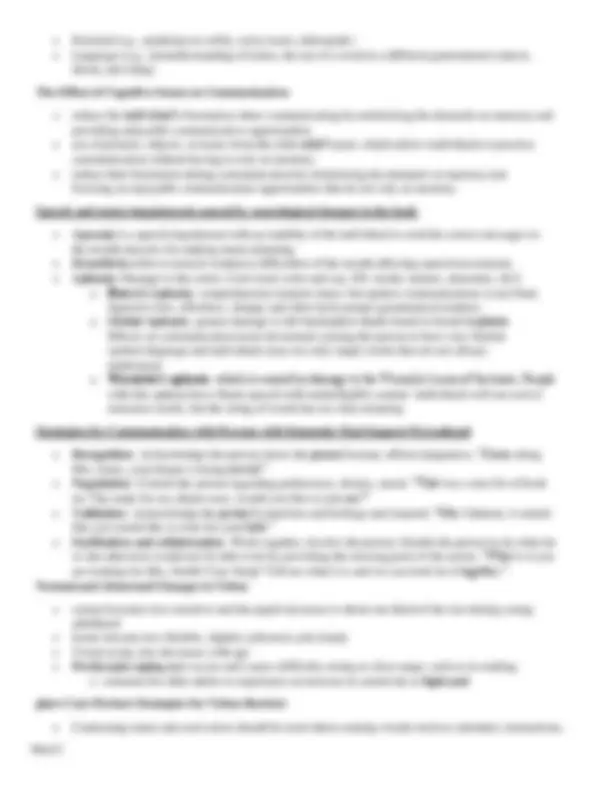
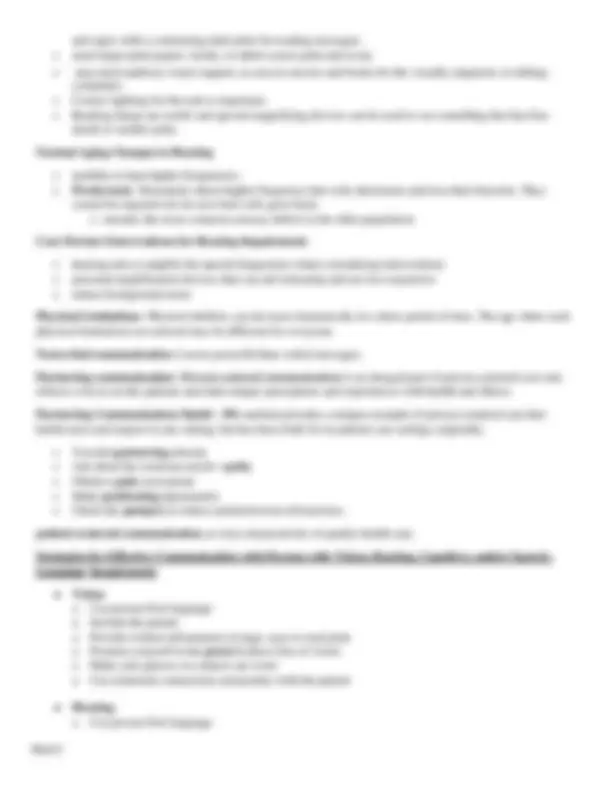
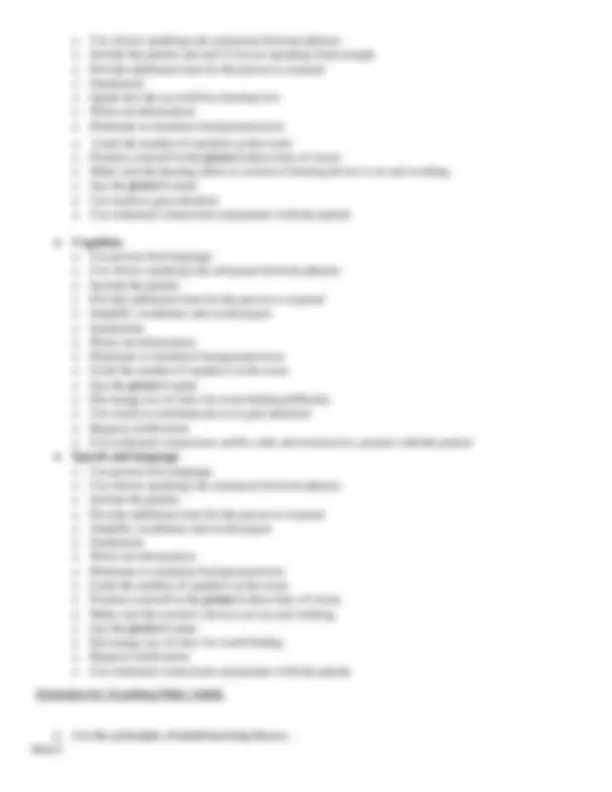
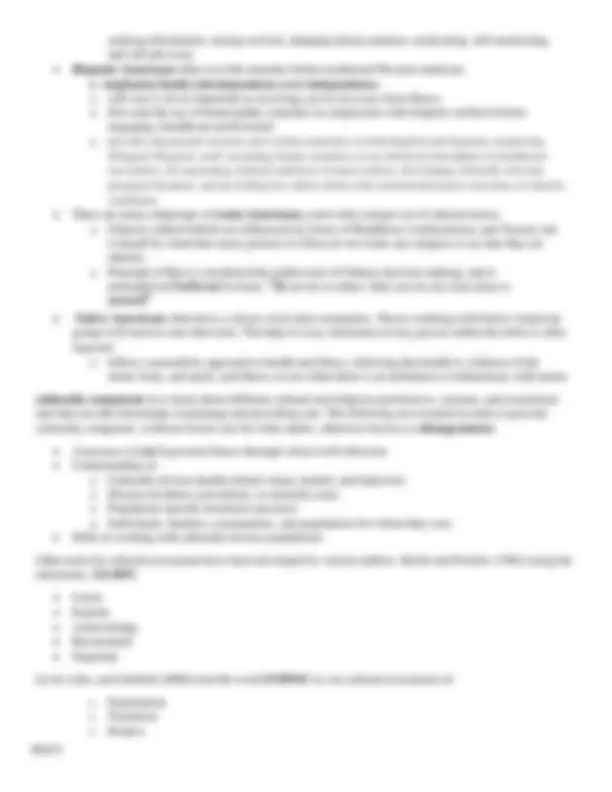
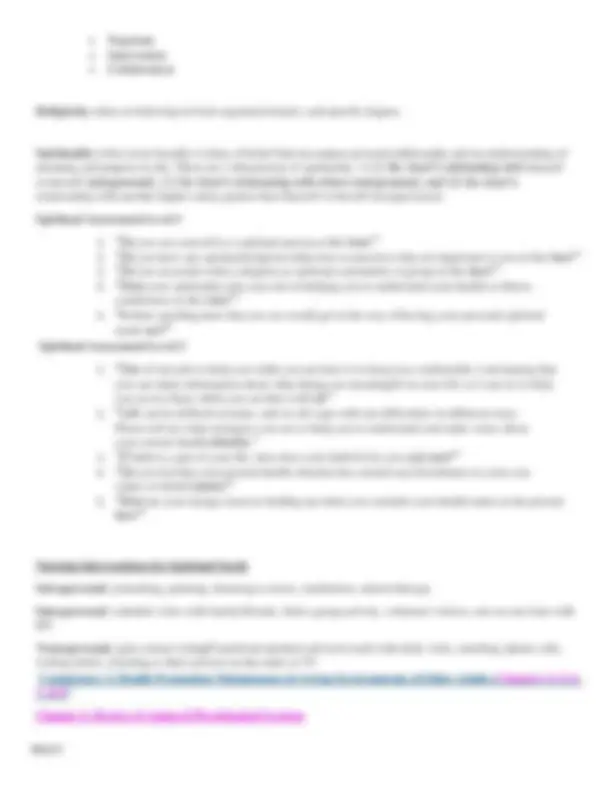
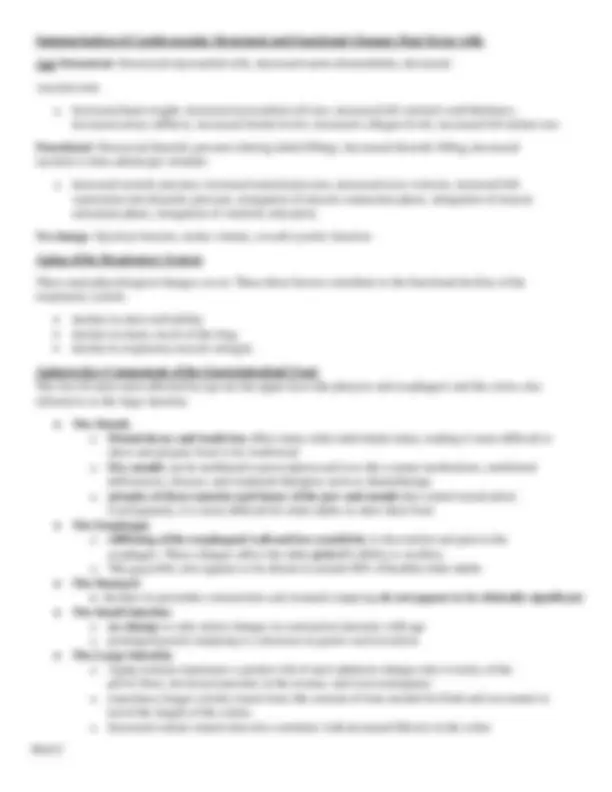
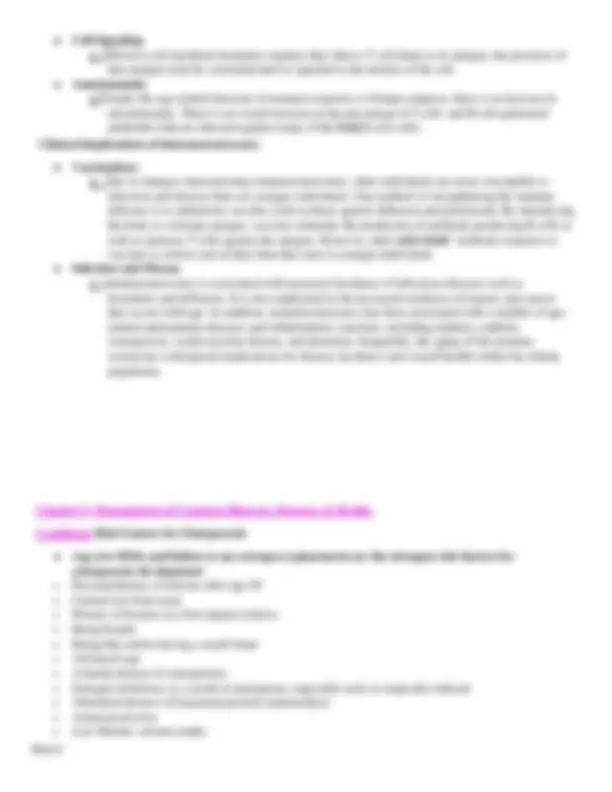
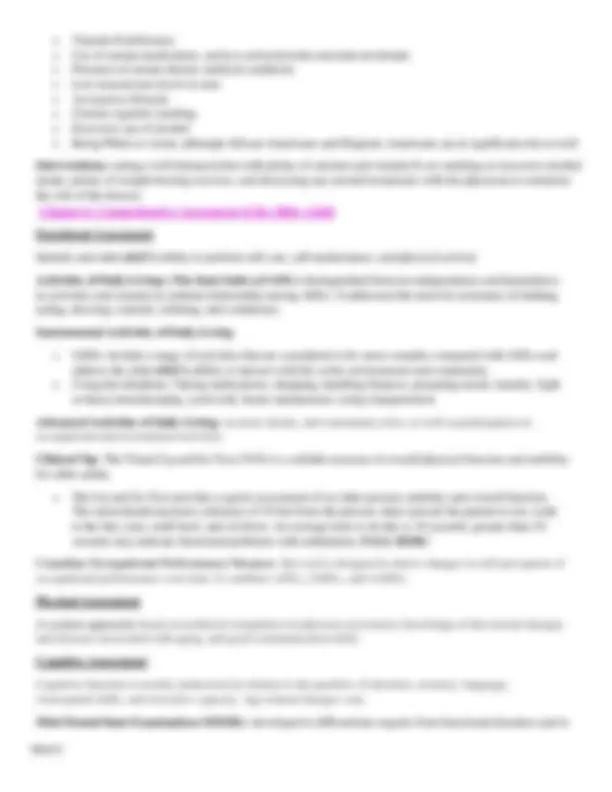
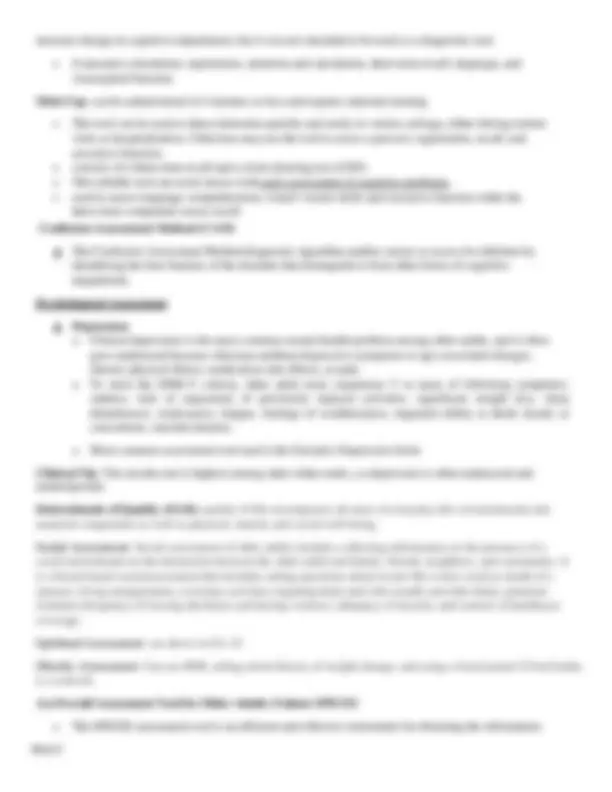
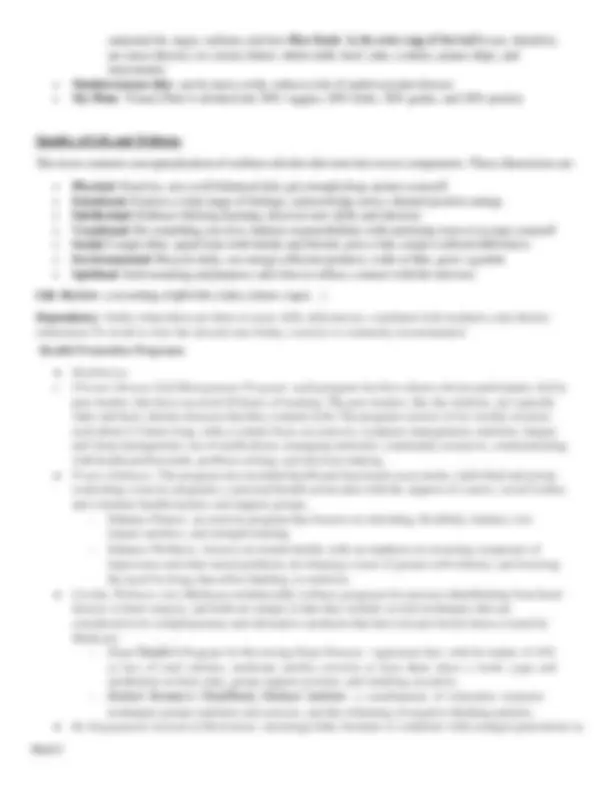
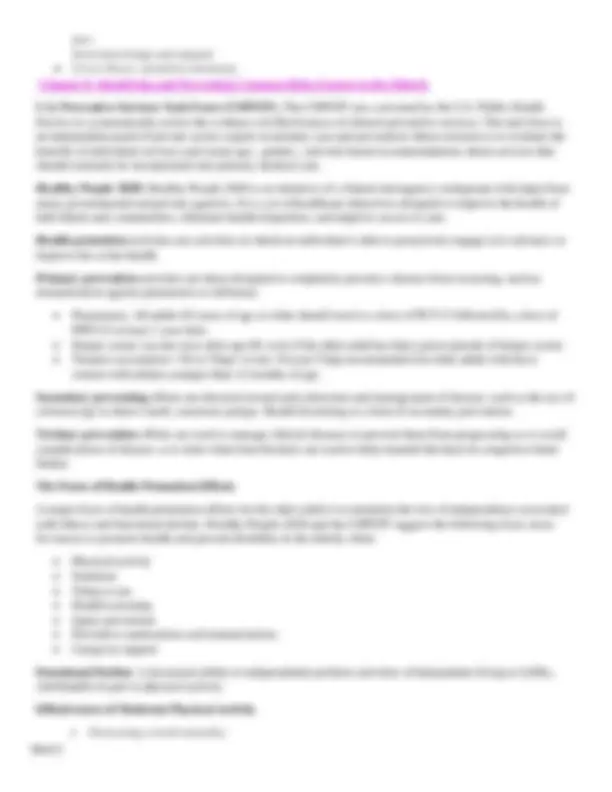
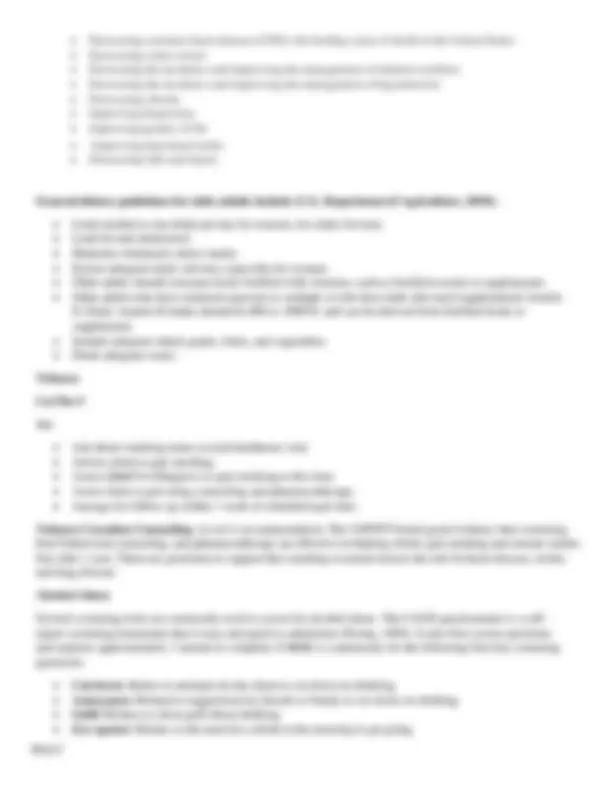
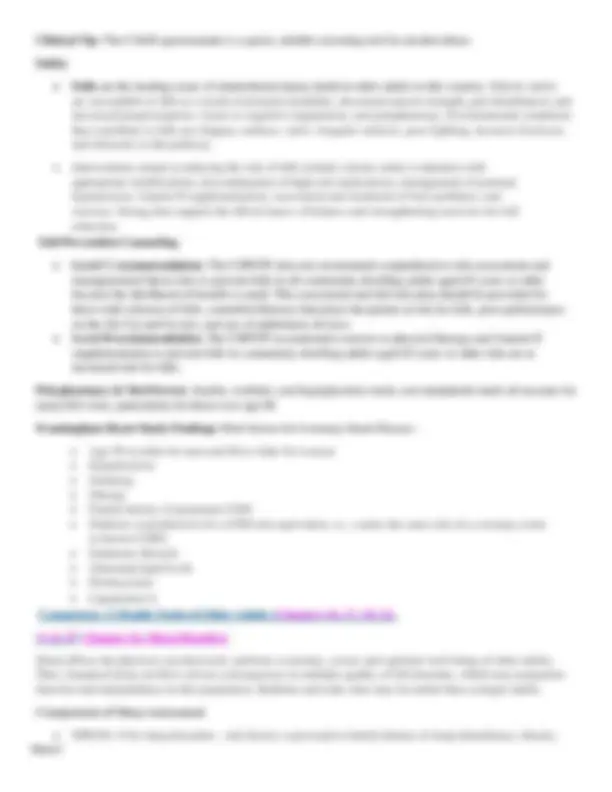
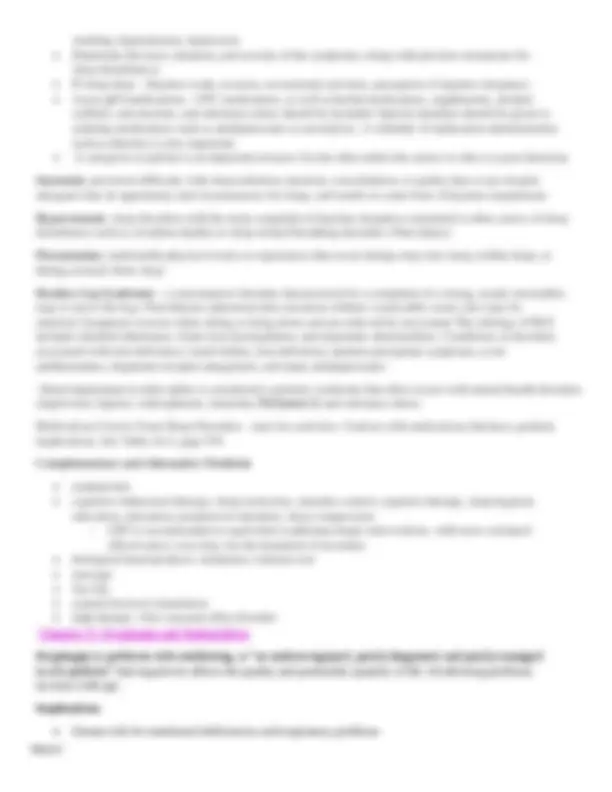
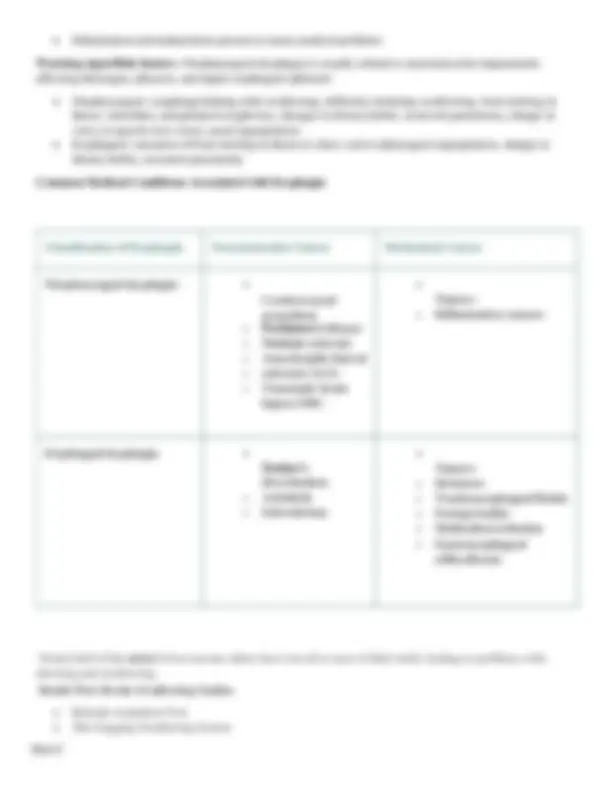
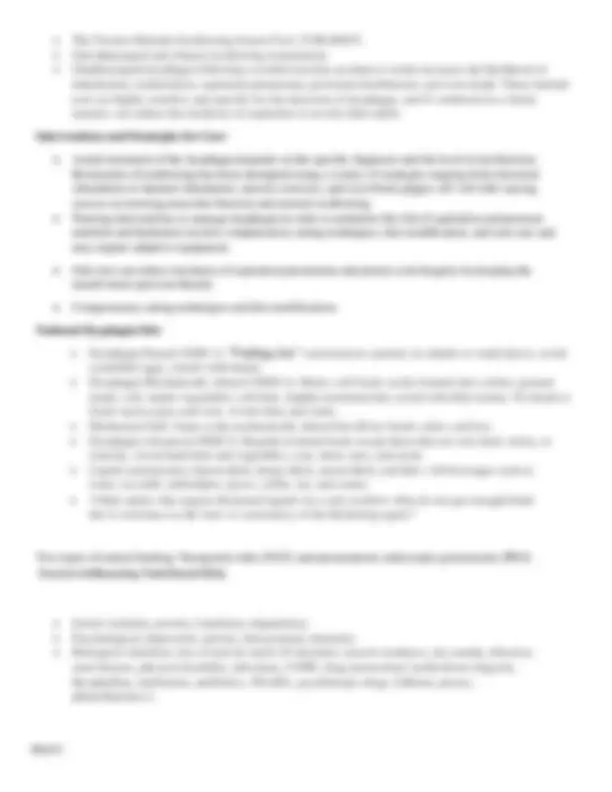
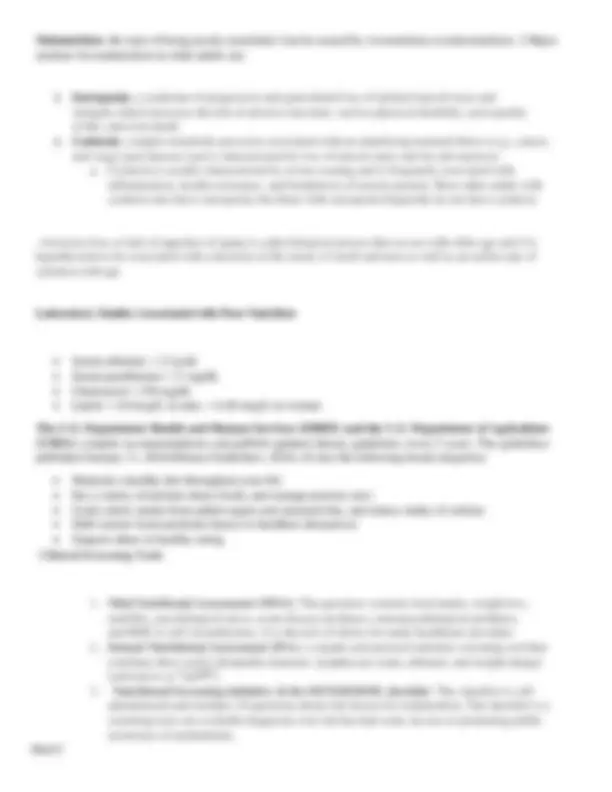
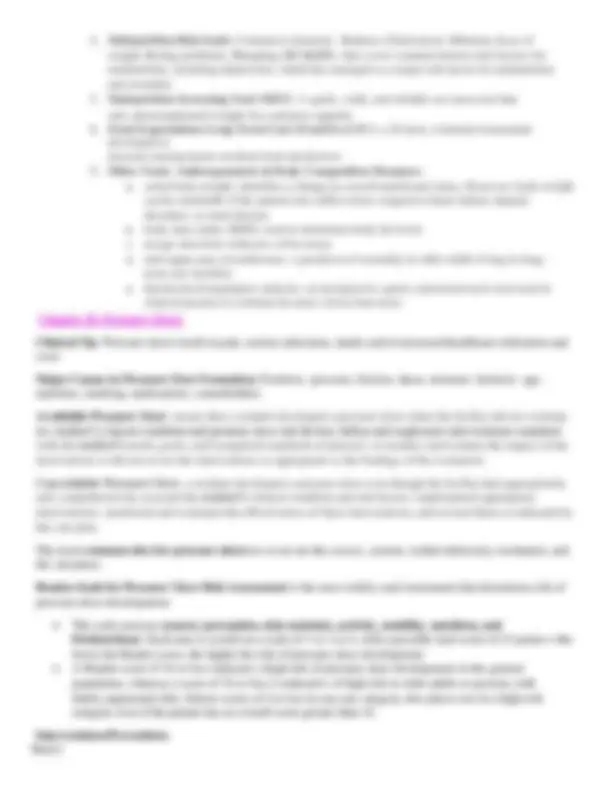
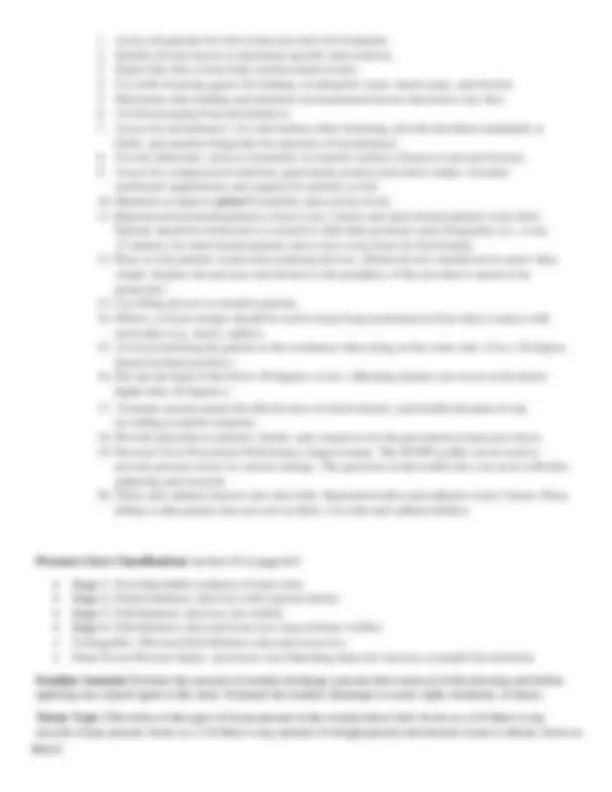
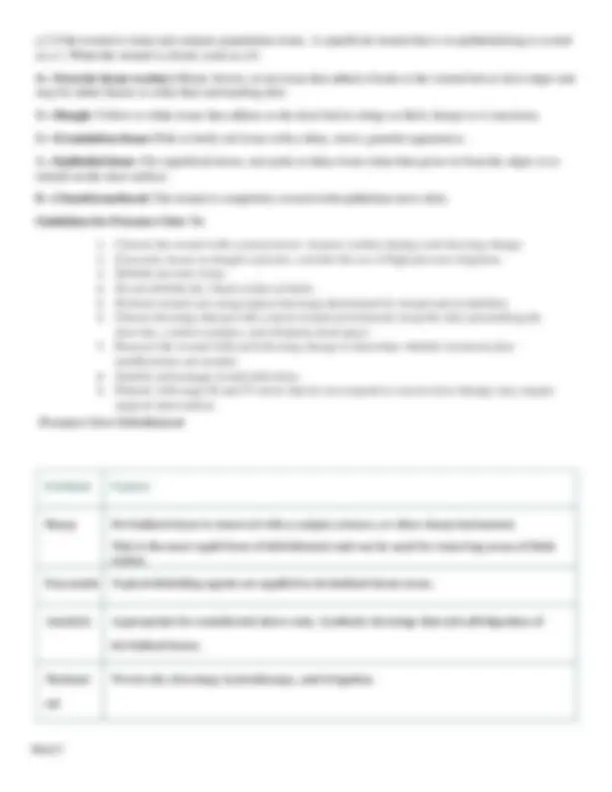
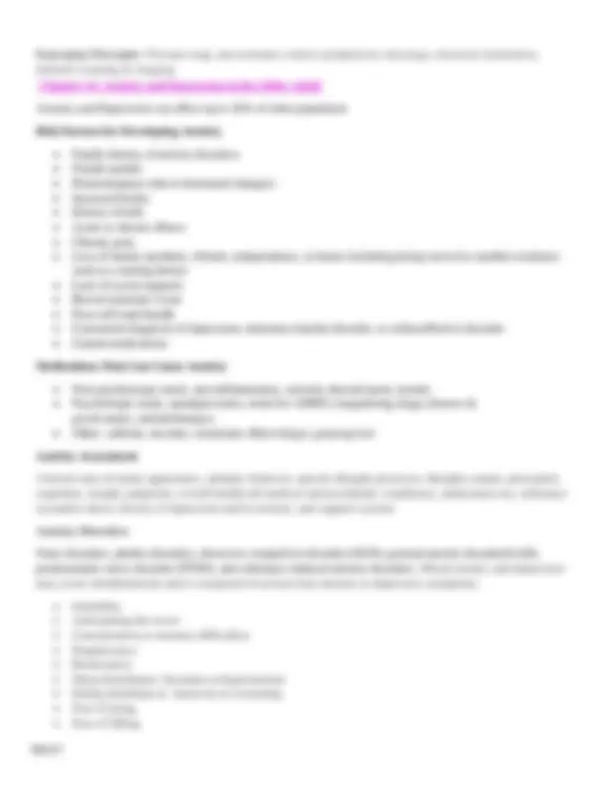
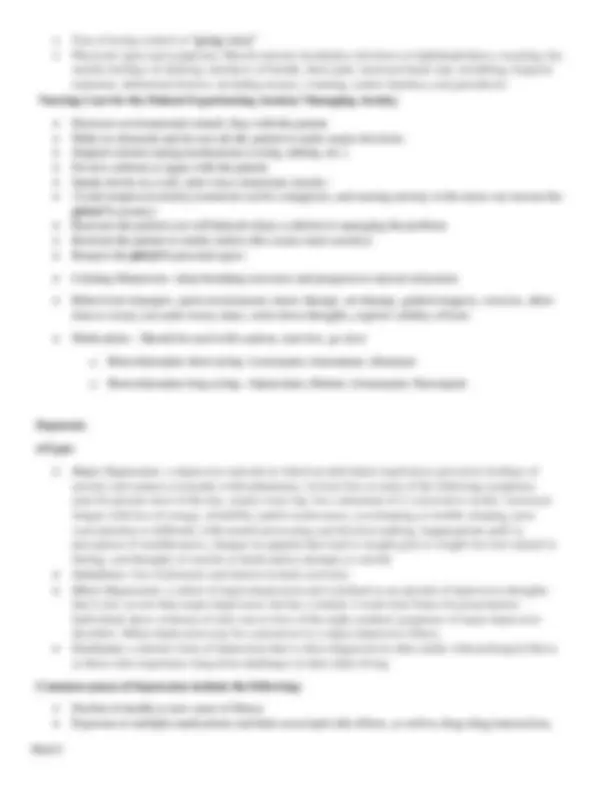
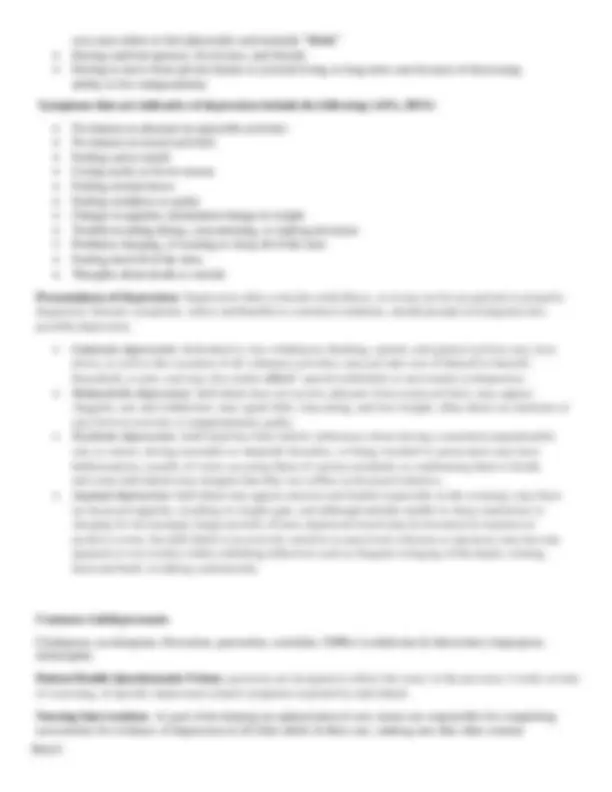
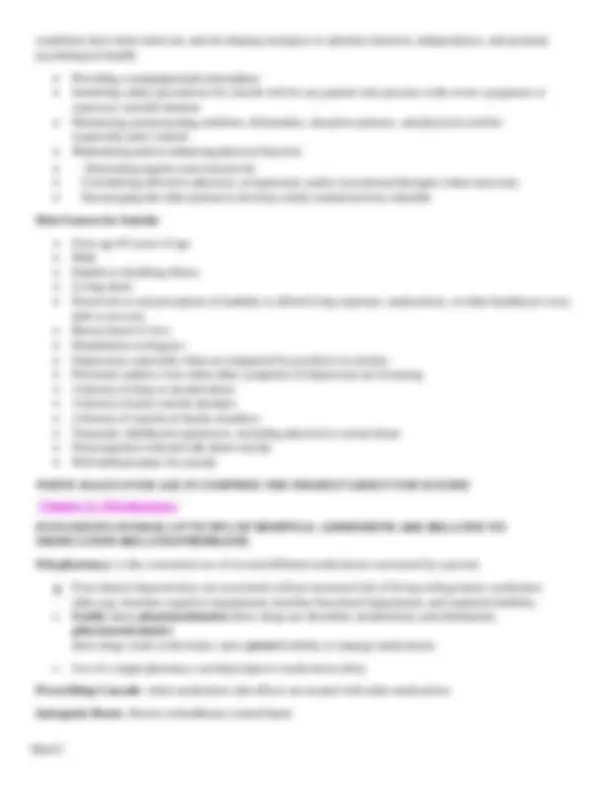
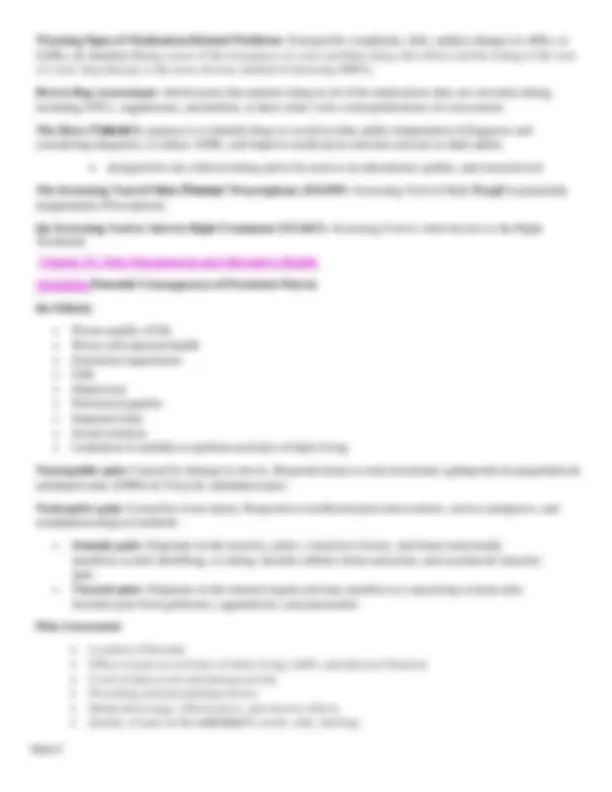
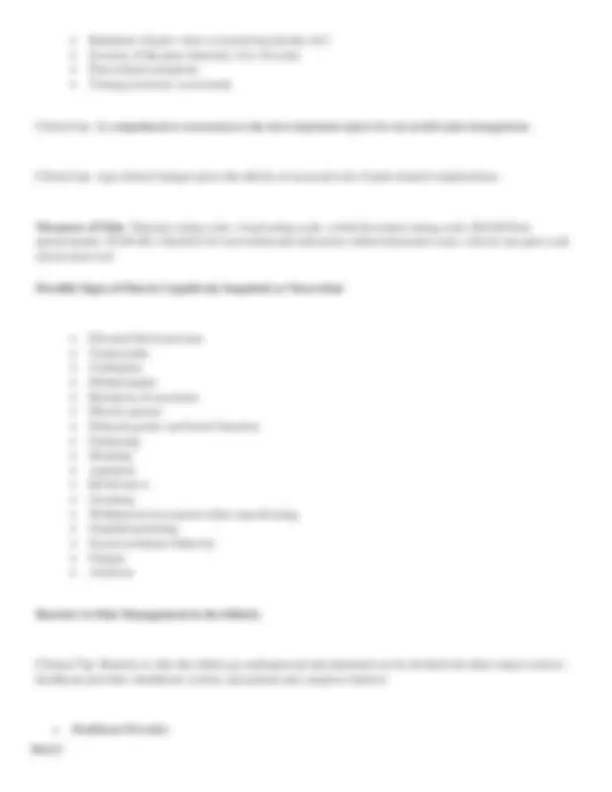
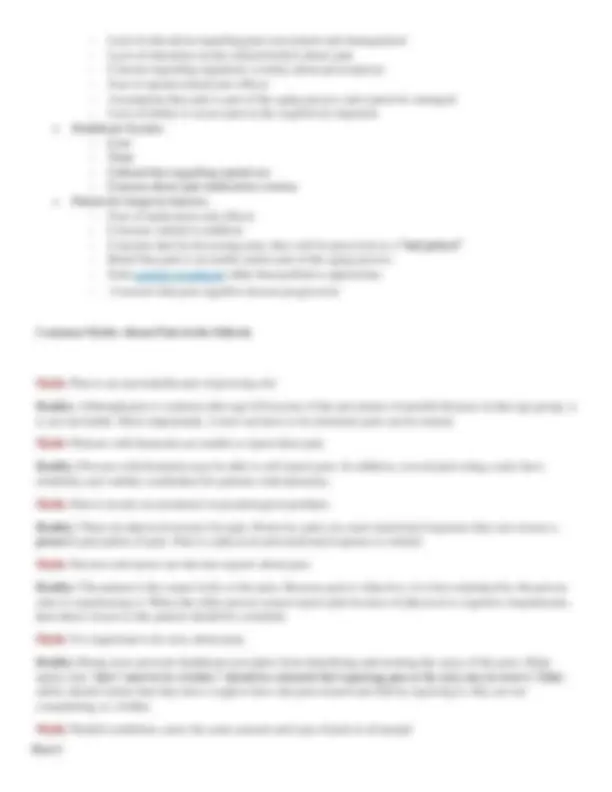
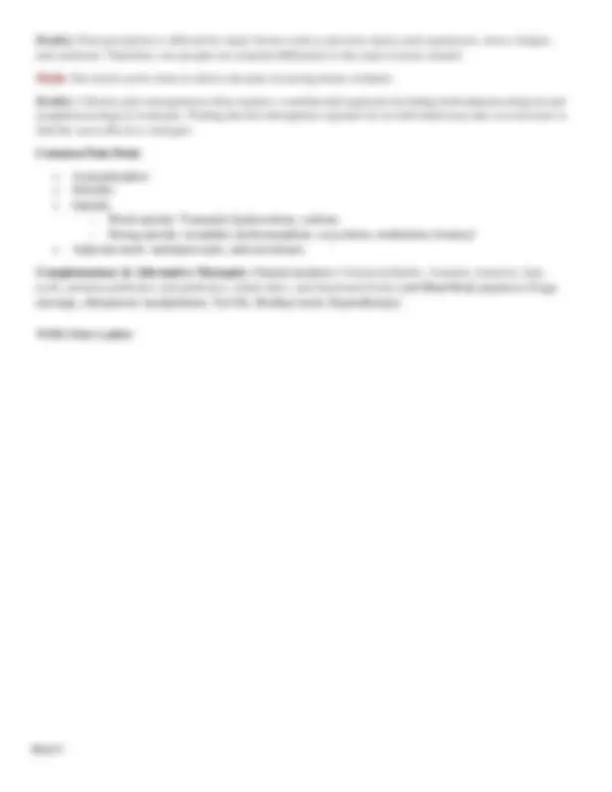
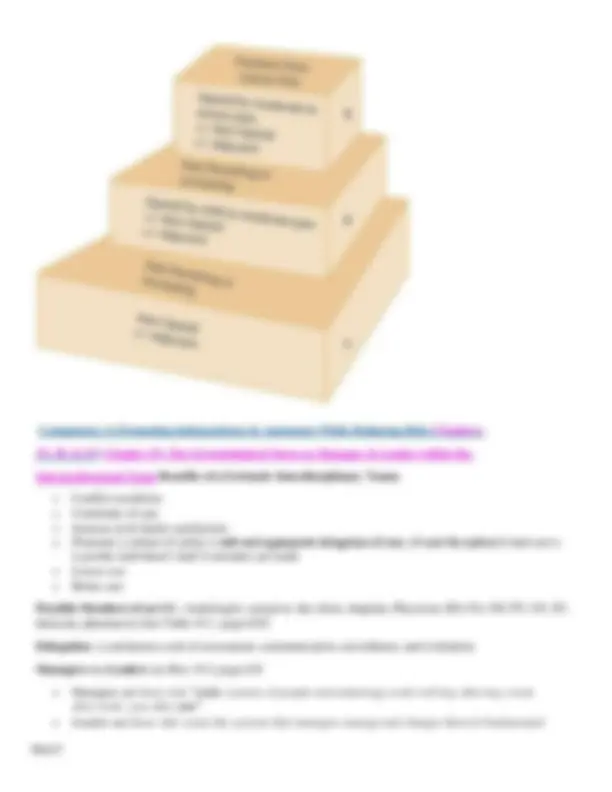
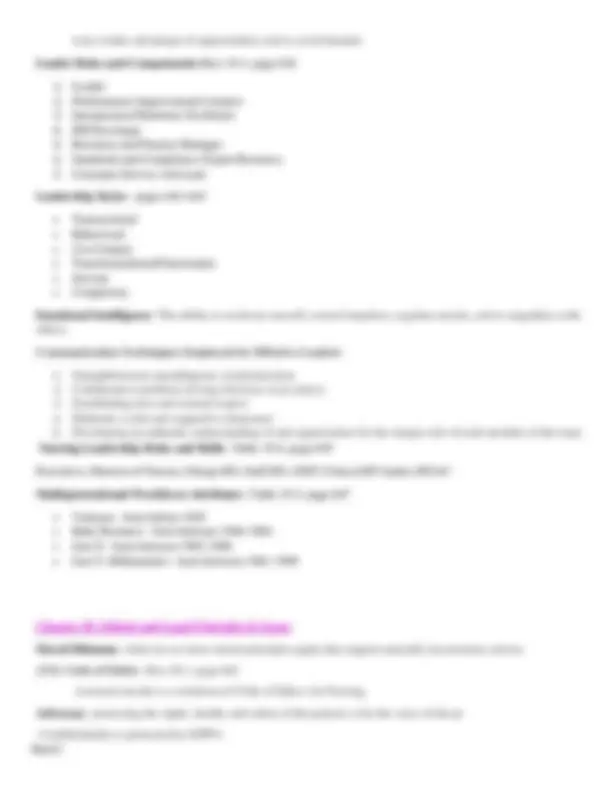
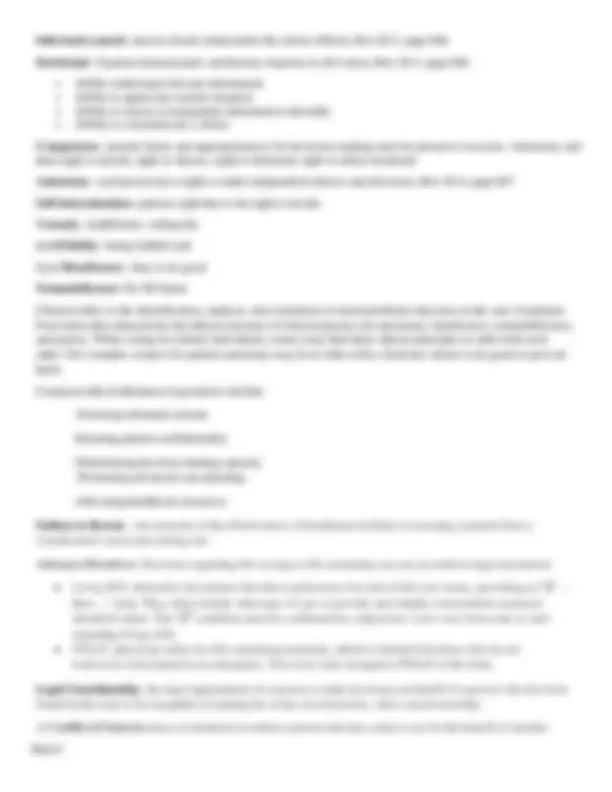
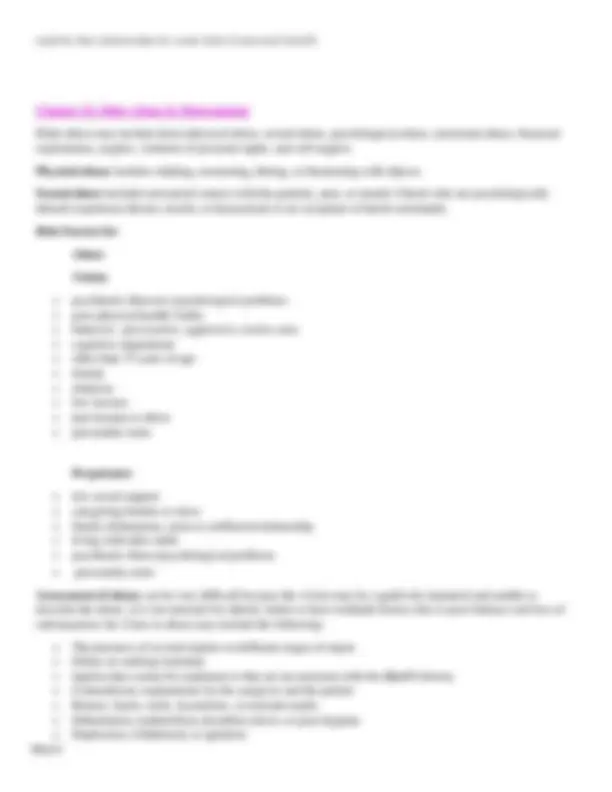
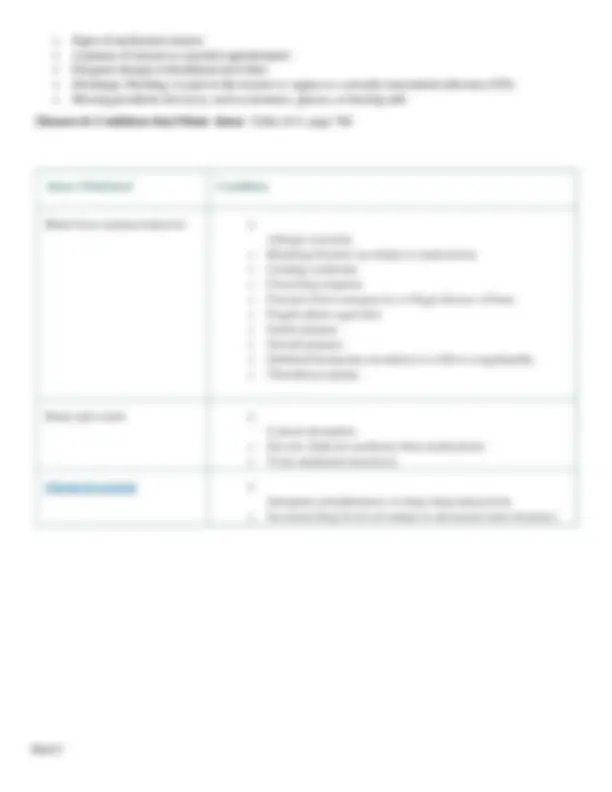
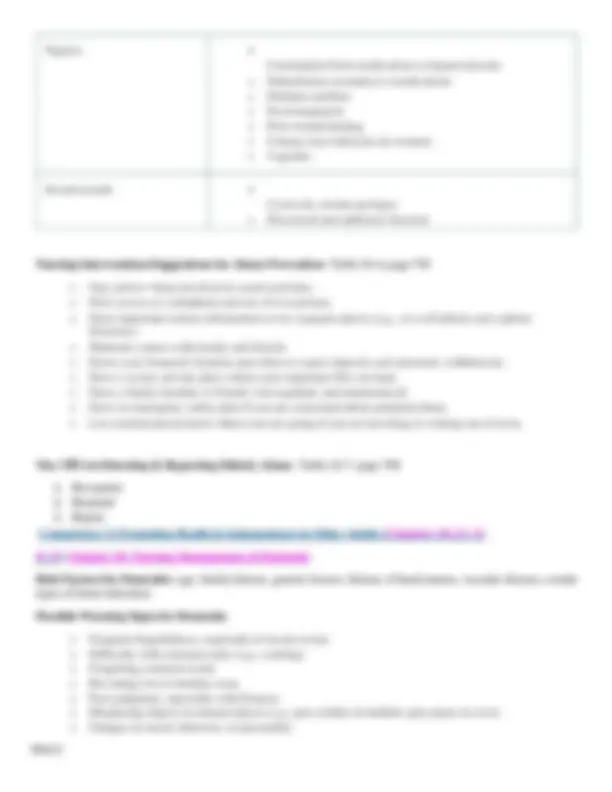
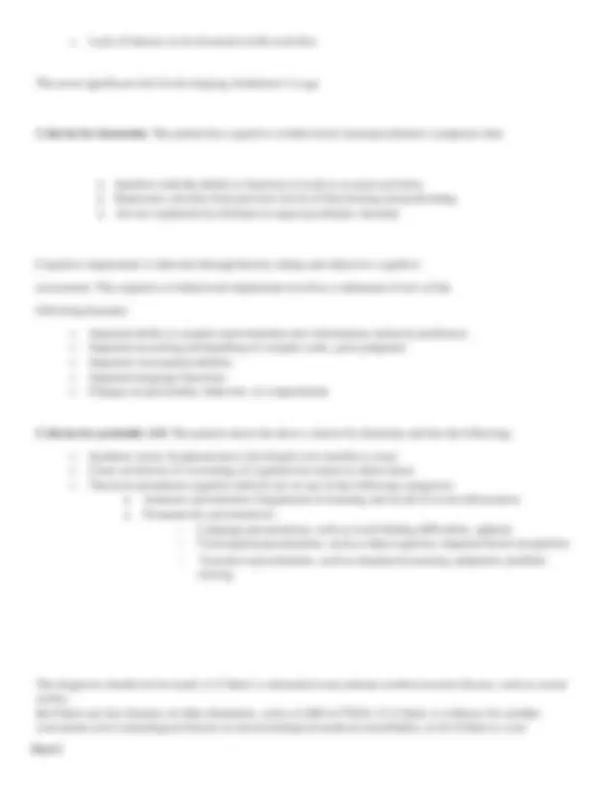
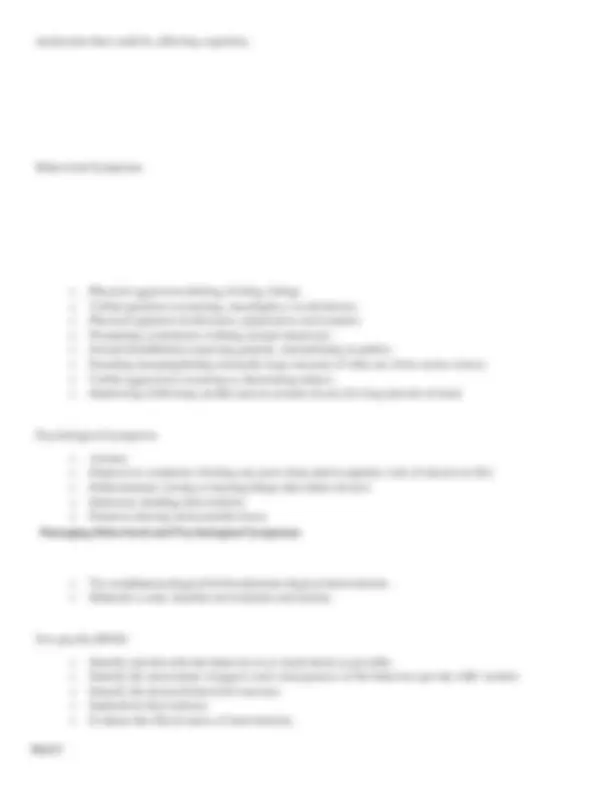
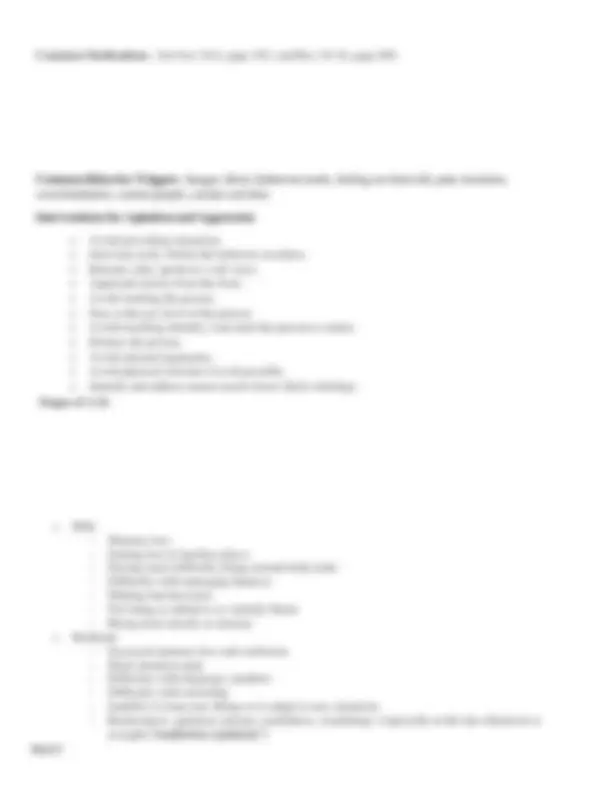
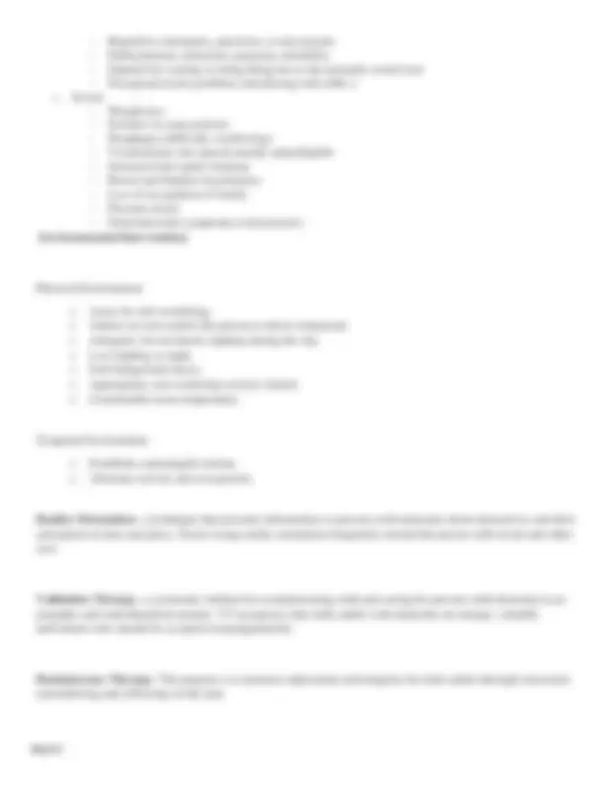
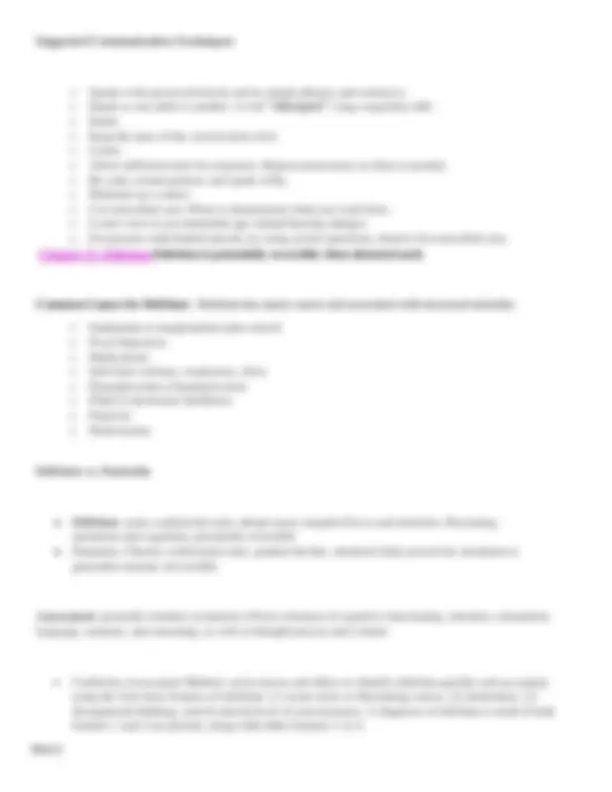
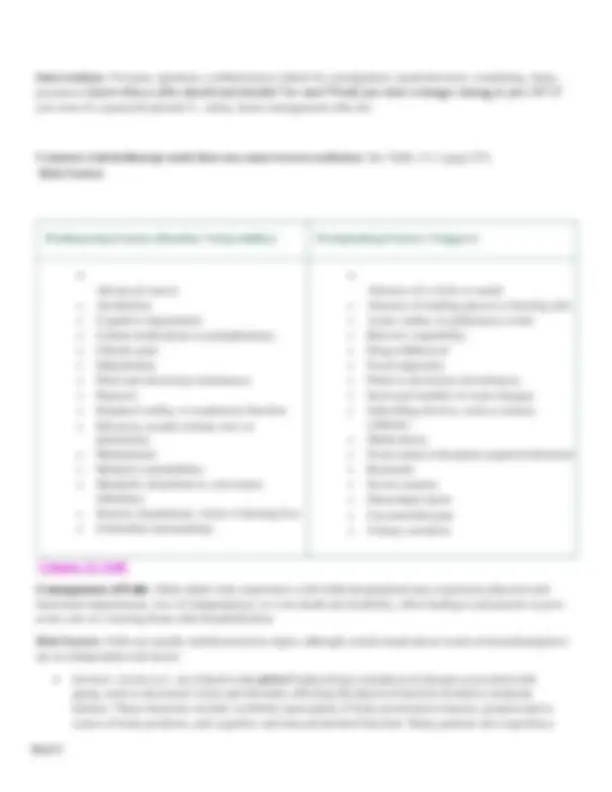
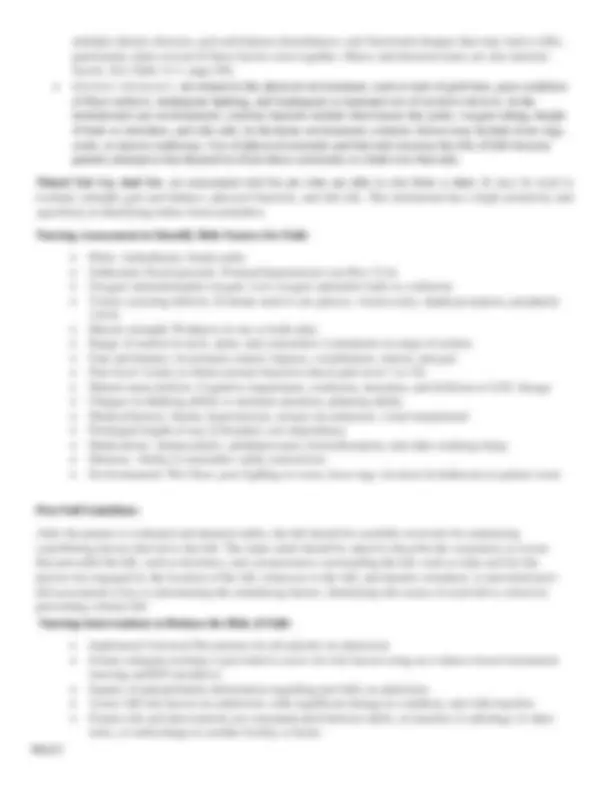
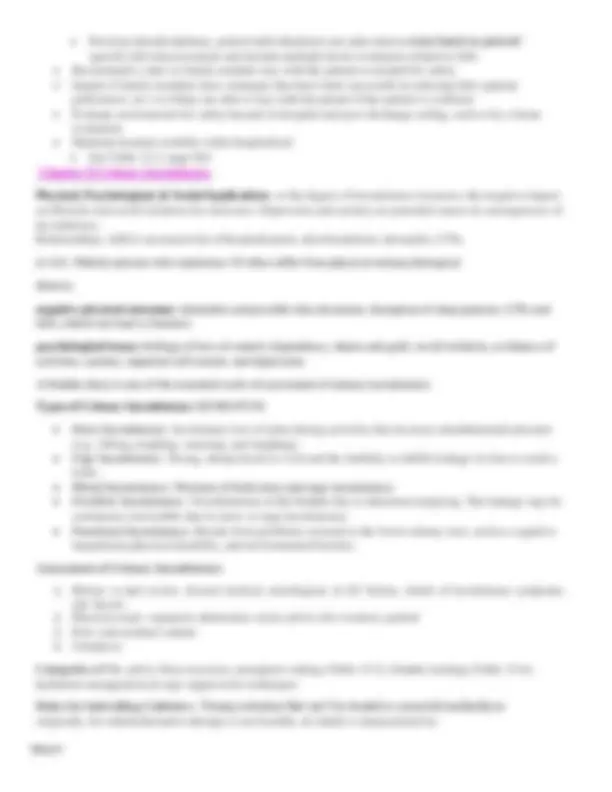
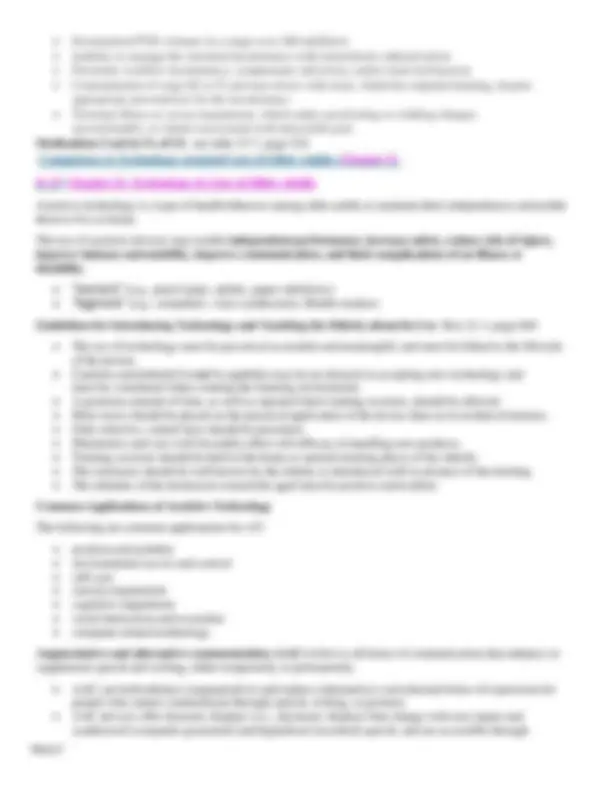
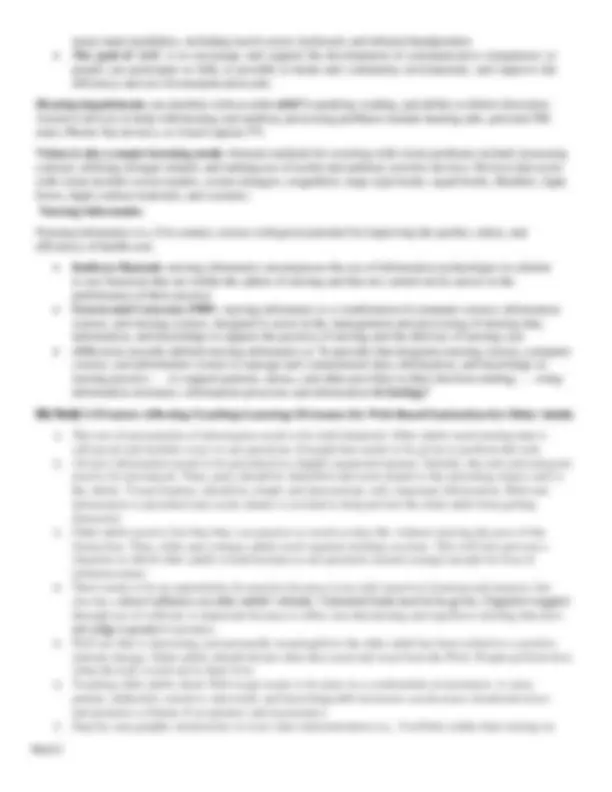




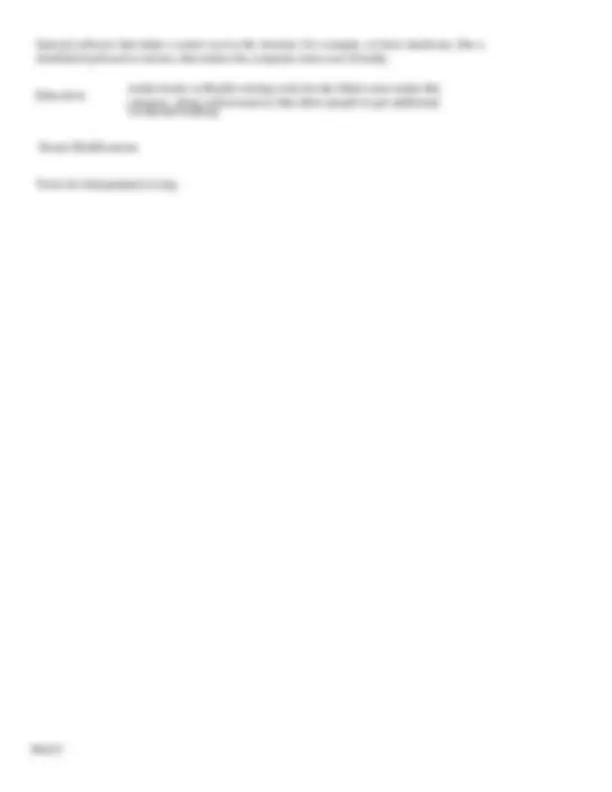






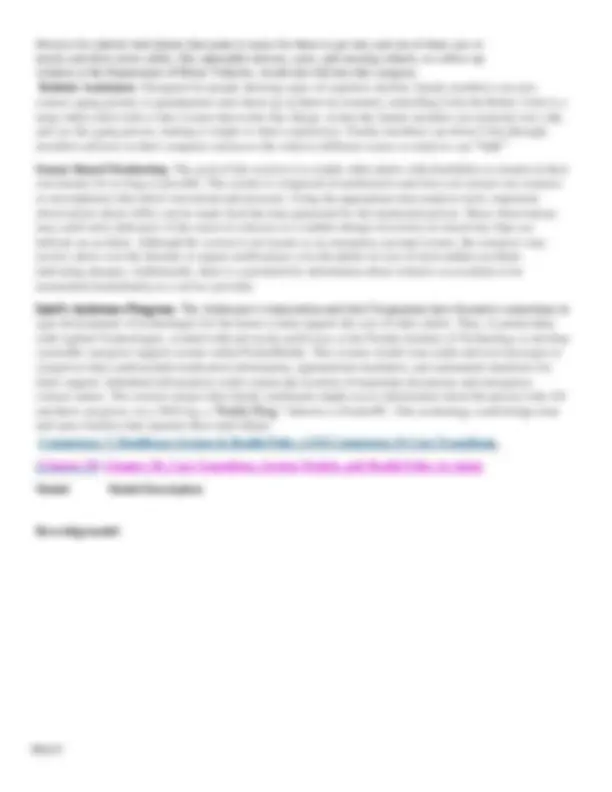


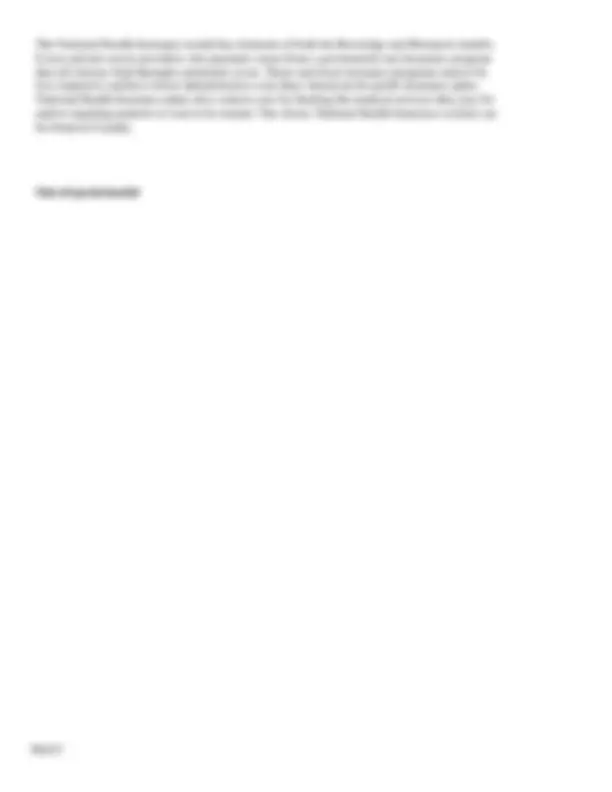
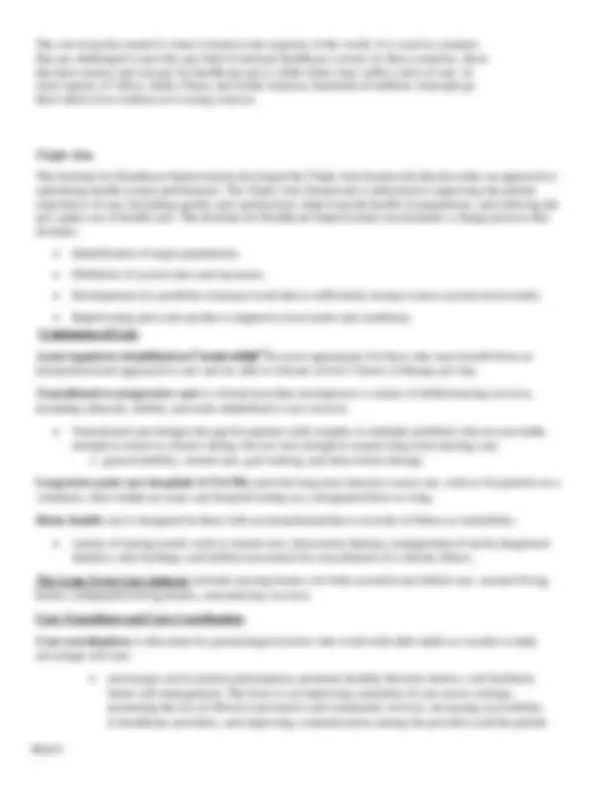
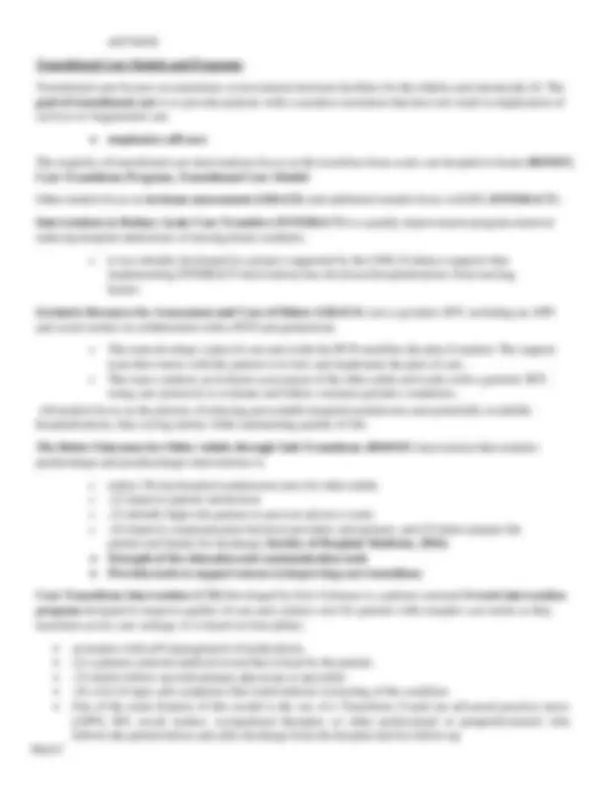
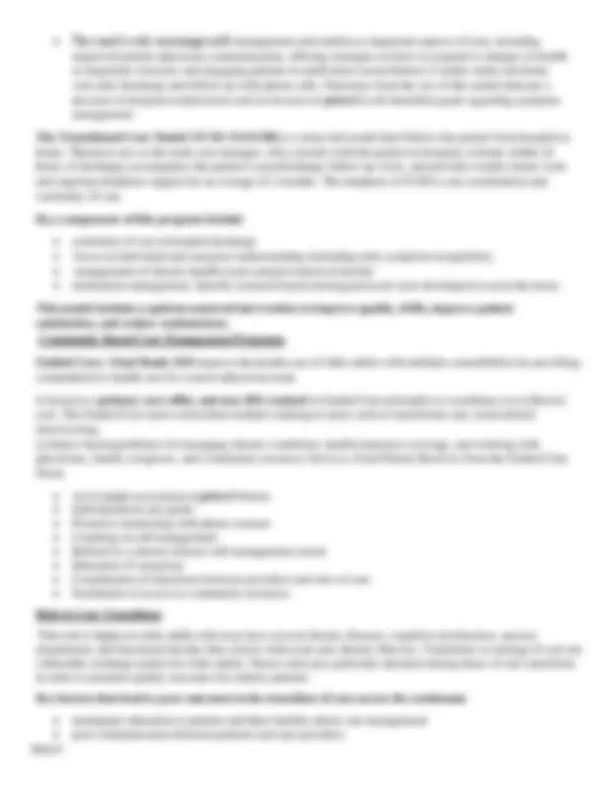
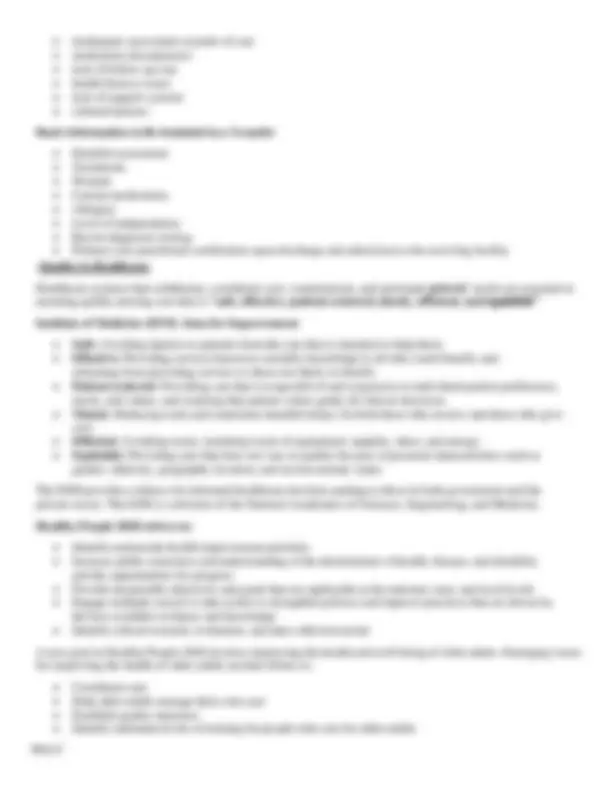
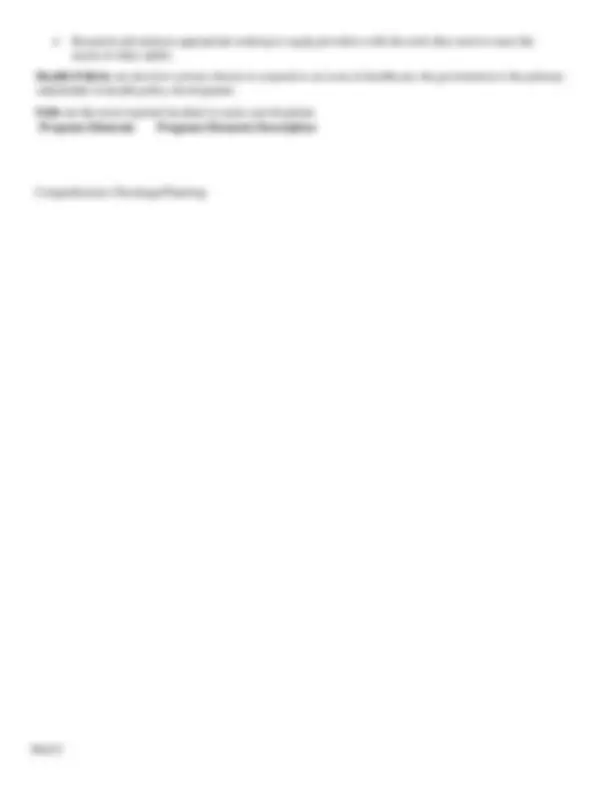





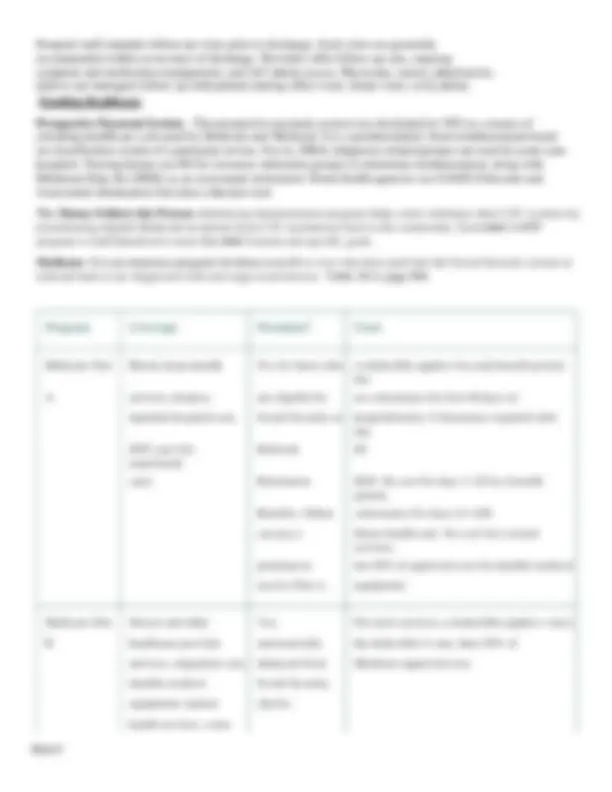

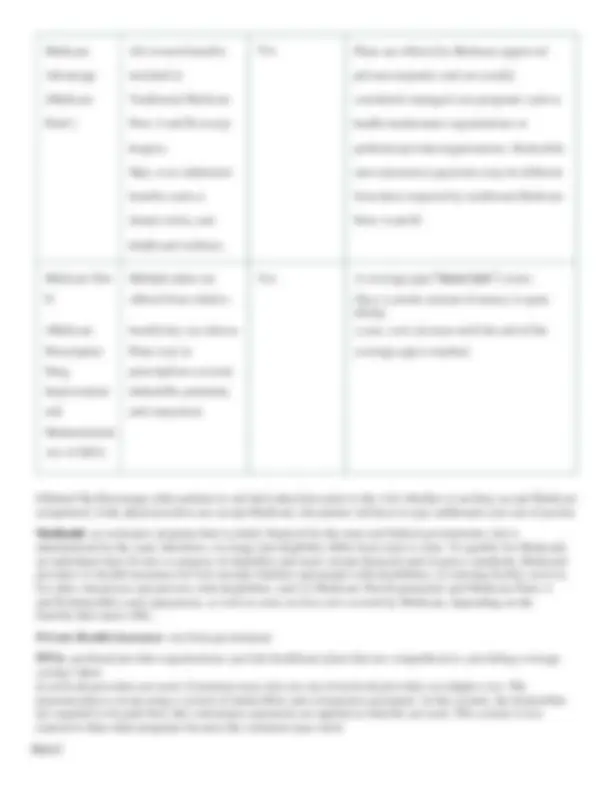
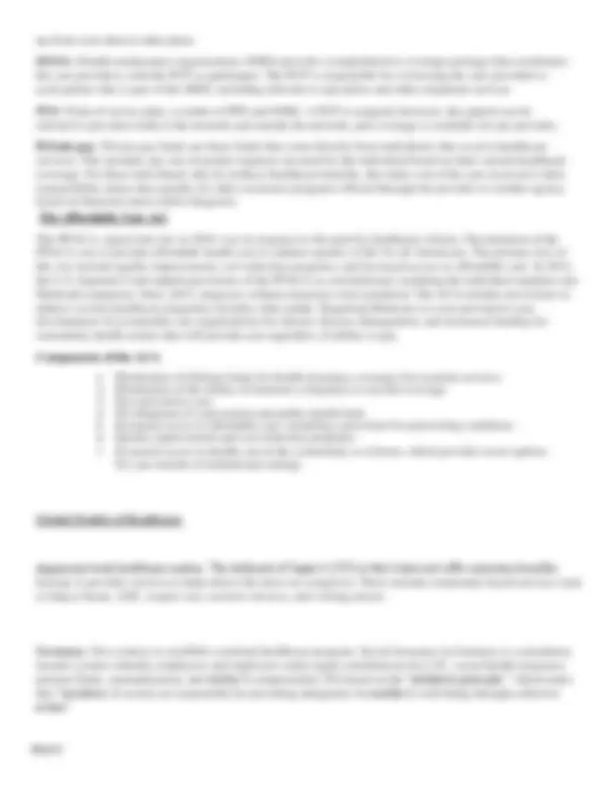

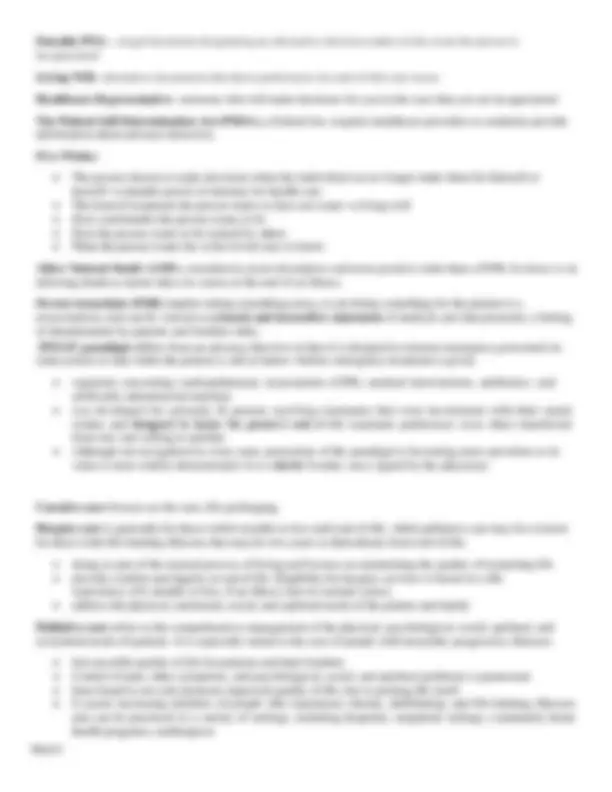
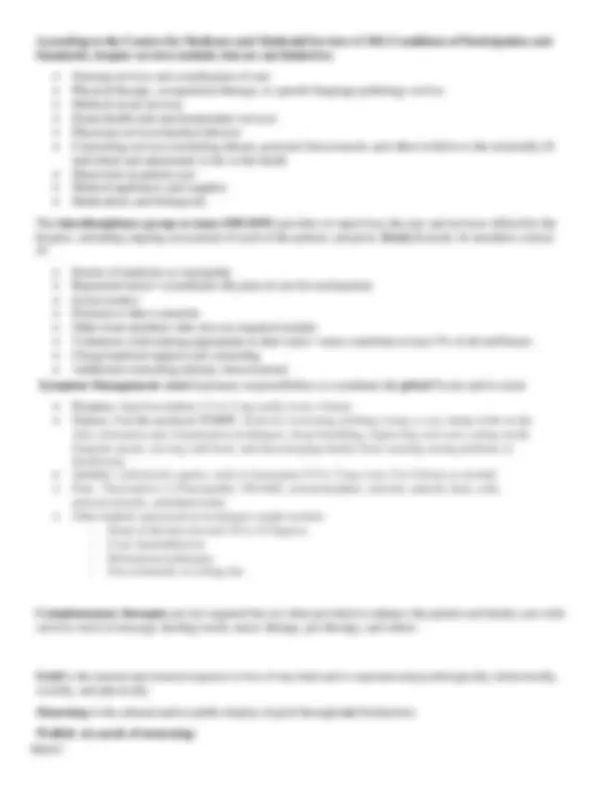
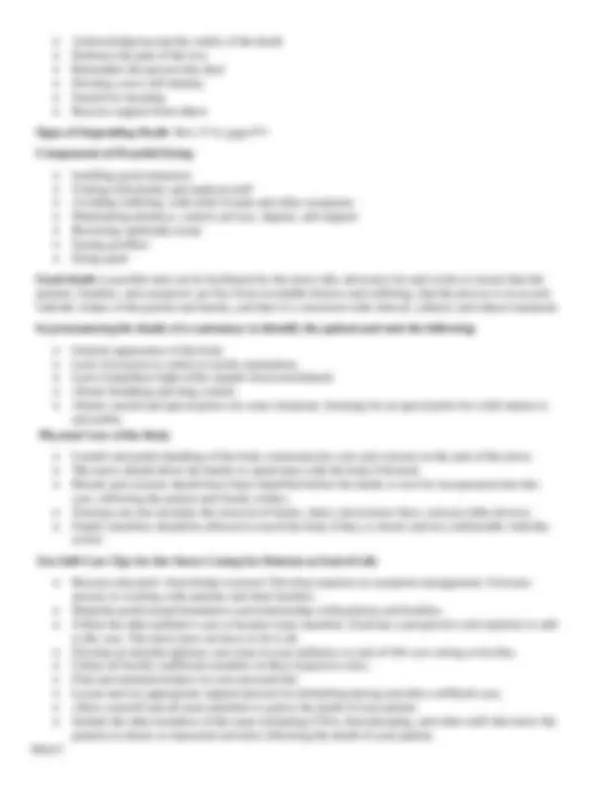
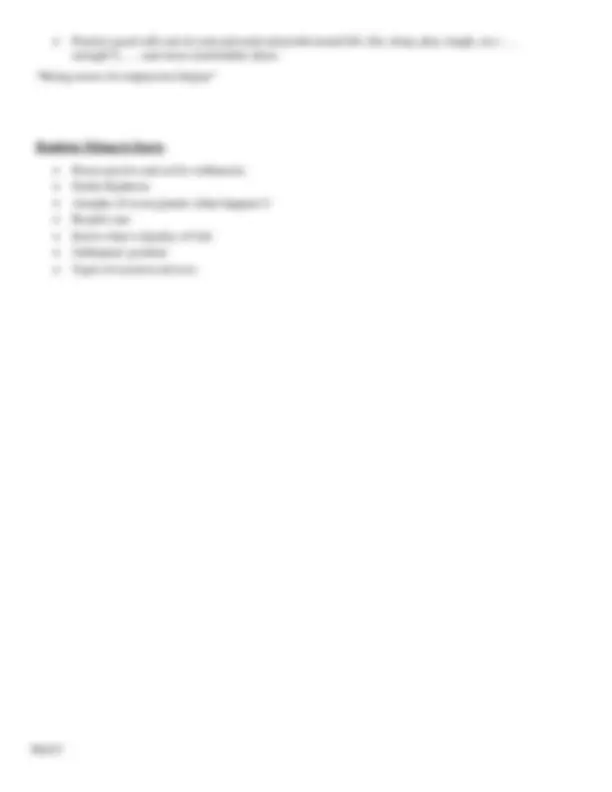


Study with the several resources on Docsity

Earn points by helping other students or get them with a premium plan


Prepare for your exams
Study with the several resources on Docsity

Earn points to download
Earn points by helping other students or get them with a premium plan
Community
Ask the community for help and clear up your study doubts
Discover the best universities in your country according to Docsity users
Free resources
Download our free guides on studying techniques, anxiety management strategies, and thesis advice from Docsity tutors
Competency 1: Compassion and Respectful Care of Older Adults
Typology: Exams
1 / 86

This page cannot be seen from the preview
Don't miss anything!















































































Chapter 1, 2 & 3 Gerontology is the broad term used to define the study of aging and/or the aged. Geriatrics is often used as a generic term relating to older adults, but specifically refers to the medical care of older adults. Geriatricians are physicians trained in geriatric medicine. ● “old” is often defined as over 65 years of age ● young old (ages 65 – 74 ● middle old (ages 75 – 84), and the old old ● frail elders (ages 85 and up) Genomics is the identification of gene sequences in the DNA Genetics is the study of heredity and the transmission of certain genes through generations Psychosocial Theories of Aging Sociological Theories - Changing roles, relationships, status, and generational cohort impact the older adult’s ability to adapt. ● Activity - Remaining occupied and involved is necessary to a satisfying late life. Society expects retirees to remain active in their communities. ● Disengagement - Gradual withdrawal from society and relationships serves to maintain social equilibrium and promote internal reflection. ● Subculture - The elderly prefer to segregate from society in an aging subculture sharing loss of status and societal negativity regarding the aged. Health and mobility are key determinants of social status. ● Continuity - Personality influences roles and life satisfaction and remains consistent throughout life. Past coping patterns recur as older adults adjust to physical, financial, and social decline and contemplate death. Identifying with one’s age group, finding a residence compatible with one’s limitations, and learning new roles postretirement are major tasks. ● Age stratification - Society is stratified by age groups that are the basis for acquiring resources, roles, status, and deference from others. Age cohorts are influenced by their historical context and share similar experiences, beliefs, attitudes, and expectations of life-course transitions. ● Person-Environment-Fit - Function is affected by ego strength, mobility, health, cognition, sensory perception, and the environment. Competency changes one’s ability to adapt to environmental demands. ● Gerotranscendence - The elderly transform from a materialistic/rational perspective toward oneness with the universe. Successful transformation includes an outward focus, accepting impending death, substantive relationships, intergenerational connectedness, and unity with the universe. Psychological Theories - Explain aging in terms of mental processes, emotions, attitudes, motivation, and personality development that is characterized by life stage transitions. ● Human needs - Five basic needs motivate human behavior in a lifelong process toward need fulfillment. ● Individualism - Personality consists of an ego and personal and collective unconsciousness that views life from a personal or external perspective. Older adults search for life meaning and adapt to functional and social losses.
● Stages of personality - Personality develops in eight sequential stages with corresponding life development tasks. The eighth phase, integrity versus despair, is characterized by evaluating life accomplishments; struggles include letting go, accepting care, detachment, and physical and mental decline. ● Life-course/life span - Life stages are predictable and structured by roles, relationships, values, development, and goals. Persons adapt to changing roles and relationships. Age-group norms and characteristics are an important part of the life course. ● Selective optimization - Individuals cope with aging losses through activity/role selection, optimization, and compensation. Critical life points are morbidity, mortality, and quality of life. Selective optimization with compensation facilitates successful aging. Biological Theories of Aging Stochastic Theories - Based on random events that cause cellular damage that accumulates as the organism ages. ● Free radical theory - Membranes, nucleic acids, and proteins are damaged by free radicals, which causes cellular injury and aging. ● Exogenous Sources of Free Radicals ( Tobacco smoke, Pesticides, Organic solvents, radiation, ozone and selected medications) ● Orgel/error theory - Errors in DNA and RNA synthesis occur with aging. Cells accumulate errors in their DNA and RNA protein synthesis that cause the cells to die ● Wear and tear theory - Cells wear out and cannot function with aging. ● Connective tissue/cross-link theory - With aging, proteins impede metabolic processes and cause trouble with getting nutrients to cells and removing cellular waste products. Nonstochastic Theories - Based on genetically programmed events that cause cellular damage that accelerates aging of the organism. ● Programmed theory - Cells divide until they are no longer able to, and this triggers apoptosis or cell death. ● Gene/biological clock theory - Cells have a genetically programmed aging code. ● Neuroendocrine theory - Problems with the hypothalamus-pituitary-endocrine gland feedback system cause disease; increased insulin growth factor accelerates aging. ● Immunological theory - Aging is due to faulty immunological function, which is linked to general well- being. Nursing Theories of Aging ● Functional consequences (Miller) theory- Environmental and biopsychosocial consequences impact functioning. Nursing’s role is risk reduction to minimize age-associated disability in order to enhance safety and quality of living. Based on a person with a disability. RN role is to maximize their abilities that they have remaining so they can have a better quality of life instead of dwelling on their disabilities. ● Theory of thriving - Failure to thrive results from a discord between the individual and his or her environment or relationships. Nurses identify and modify factors that contribute to disharmony among these elements. Based on long term care pts and cascade of events that occur when a pt is in a long term care facility. Characteristics that happen: fatigue, generalized weakness, malnutrition because the pt doesn’t want to eat , cognitive dysfunction. The environment dictates how you age. If you are not in an environment that you can’t thrive in, you won’t thrive and you won’t age well. Chapter 5 - Teaching and Communication with Older Adults and their families Normal and abnormal aging barriers might be: ● Internal (e.g., cognition and physical deficits)
and signs with a contrasting dark print for reading messages. ● need larger print papers, books, or tablet screen print and icons. ● may need auditory visual support, as seen in movies and books for the visually impaired, or talking computers. ● Correct lighting for the task is important. ● Reading lamps are useful and special magnifying devices can be used to see something that has fine detail or smaller print. Normal Aging Changes in Hearing ● inability to hear higher frequencies. ● Presbycusis - Permanent where higher frequency hair cells deteriorate and lose their function. They cannot be repaired nor do new hair cells grow back. o remains the most common sensory deficit in the older population Care Partner Interventions for Hearing Impairments ● hearing aids to amplify the speech frequencies when considering interventions ● personal amplification devices that can aid in hearing and are less expensive ● reduce background noise Physical Limitations- Physical abilities can decrease dramatically in a short period of time. The age when such physical limitations are noticed may be different for everyone. Nonverbal communication is more powerful than verbal messages. Partnering communication- Person-centered communication is an integral part of person-centered care and reflects a focus on the patients and their unique perceptions and experiences with health and illness. Partnering Communication Model - 5Ps method provides a unique example of person-centered care that builds trust and respect in any setting, but has been built for in-patient care settings originally. ● You did partnering already ● Ask about the restroom needs— potty ● Obtain a pain assessment ● Make positioning adjustments. ● Check the pump(s) to reduce potential noise distractions. patient-centered communication as a key characteristic of quality health care. Strategies for Effective Communication with Persons with Vision, Hearing, Cognitive, and/or Speech– Language Impairments ● Vision o Use person-first language o Include the patient o Provide written information in large, easy to read print o Position yourself in the person’s direct line of vision o Make sure glasses or contacts are worn o Use relational connections and partner with the patient ● Hearing o Use person-first language
o Use slower speaking rate and pause between phrases o Include the patient and ask if you are speaking loud enough o Provide additional time for the person to respond o Summarize o Speak into the ear with less hearing loss o Write out information o Eliminate or minimize background noise o Limit the number of speakers in the room o Position yourself in the person’s direct line of vision o Make sure the hearing aid(s) or assistive listening device is on and working o Say the person’s name o Use touch to gain attention o Use relational connections and partner with the patient ● Cognition o Use person-first language o Use slower speaking rate and pause between phrases o Include the patient o Provide additional time for the person to respond o Simplify vocabulary and avoid jargon o Summarize o Write out information o Eliminate or minimize background noise o Limit the number of speakers in the room o Say the person’s name o Encourage use of clues for word-finding difficulty o Use touch to communicate or to gain attention o Request clarification o Use relational connections and be calm and nonreactive, partner with the patient ● Speech and language o Use person-first language o Use slower speaking rate and pause between phrases o Include the patient o Provide additional time for the person to respond o Simplify vocabulary and avoid jargon o Summarize o Write out information o Eliminate or minimize background noise o Limit the number of speakers in the room o Position yourself in the person’s direct line of vision o Make sure the assistive devices are on and working o Say the person’s name o Encourage use of clues for word-finding o Request clarification o Use relational connections and partner with the patient Strategies for Teaching Older Adults
1. Use the principles of adult learning theory:
AAC- Augmentative and Alternative Communication →hearing aids, picture boards, computers with voice synthesizers Strategies for older adults to promote higher levels of success with technology, as follows: ● Develop a structured and simple interface process ● Maintain feedback processes offering ways to make adjustments ● Be ready to assist the user in how he or she thinks through an issue and give guidance for decision making ● Integrate learning principles allowing for diverse ways of gaining information ● Simple, consistent keys ● Uncluttered screens, without multiple apps ● A talking interface or problem-solving ques for a single social media platform Chapter 22 - Culture and Spirituality ● European Americans value the healthcare system and tend to rely on science to explain health and illness. o generally do not have as close ties to their extended families as other cultural groups within the United States o tend to be individualistic when it comes to health care, often presenting a stoic attitude about illness, so as not to “be a burden” on others o accepting of the paternalistic nature of the healthcare system, are generally more trusting of authority, and therefore tend to follow the advice of healthcare providers to engage in more physical and mental activity than other cultural groups ● African Americans tend not to want to put their older relatives in nursing homes, rather choosing to care for them at home. o role of religion and spirituality plays an important part in the African American health and wellness belief system o equate good luck, good fortune, and good health with “being right with God.” o tend to rely on their close family ties or close neighbors when in need of support rather than turning inward, as with other cultural groups. o coping strategies for chronic health conditions: dealing with it, engaging in life, exercising,
seeking information, relying on God, changing dietary patterns, medicating, self-monitoring, and self-advocacy ● Hispanic Americans often use folk remedies before traditional Western medicine. o emphasize family interdependence over independence. o self-care is not as important as receiving care in recovery from illness. o first seek the use of homeopathic remedies in conjunction with religious artifacts before engaging a healthcare professional o provide educational sessions and written materials in both English and Spanish, employing bilingual Hispanic staff, including family members in an informal atmosphere in healthcare encounters, incorporating cultural traditions in interventions, developing culturally relevant program literature, and providing fact sheets about risks and potential poor outcomes of chronic conditions ● There are many subgroups of Asian Americans, each with a unique set of cultural norms. o Chinese cultural beliefs are influenced by forms of Buddhism, Confucianism, and Taoism, but it should be noted that many persons in China do not claim any religion or say that they are atheists. o Principle of Ren is considered the golden rule of Chinese decision making, and is embodied in Confucius’s axiom, “Do not do to others what you do not want done to yourself” ● Native Americans often have a closed, close-knit community. Nurses working with Native American groups will need to earn their trust. The help of a key informant (or key person within the tribe) is often required. o follow a naturalistic approach to health and illness, believing that health is a balance of the mind, body, and spirit, and illness occurs when there is an imbalance or disharmony with nature culturally competent- i s to learn about different cultural and religious preferences, customs, and restrictions and then use this knowledge in planning and providing care. The following are essential in order to provide culturally competent, evidence-based care for older adults, otherwise known as ethnogeriatrics ● Awareness of one’s personal biases through critical self-reflection ● Understanding of: o Culturally diverse health-related values, beliefs, and behaviors o Disease incidence, prevalence, or mortality rates o Population-specific treatment outcomes o Individuals, families, communities, and populations for whom they care ● Skills in working with culturally diverse populations Other tools for cultural assessment have been developed by various authors. Berlin and Fowkes (1982) using the mnemonic, LEARN : ● Listen ● Explain ● Acknowledge ● Recommend ● Negotiate Levin, Like, and Gottlieb (2000) used the word ETHNIC to cue cultural assessment of: ● Explanation ● Treatment ● Healers
Summarization of Cardiovascular Structural and Functional Changes That Occur with Age Structural - Decreased myocardial cells, decreased aortic distensibility, decreased vascular tone o Increased heart weight, increased myocardial cell size, increased left ventricle wall thickness, increased artery stiffness, increased elastin levels, increased collagen levels, increased left atrium size Functional - Decreased diastolic pressure (during initial filling), decreased diastolic filling, decreased reaction to beta-adrenergic stimulus o Increased systolic pressure, increased arterial pressure, increased wave velocity, increased left ventricular end-diastolic pressure, elongation of muscle contraction phase, elongation of muscle relaxation phase, elongation of ventricle relaxation No change - Ejection fraction, stroke volume, overall systolic function Aging of the Respiratory System Three main physiological changes occur: These three factors contribute to the functional decline of the respiratory system. ● decline in chest wall ability ● decline in elastic recoil of the lung ● decline in respiratory muscle strength. Aging in Key Components of the Gastrointestinal Tract The two GI areas most affected by age are the upper tract (the pharynx and esophagus) and the colon, also referred to as the large intestine ● The Mouth o Dental decay and tooth loss affect many older individuals today, making it more difficult to chew and prepare food to be swallowed o Dry mouth can be attributed to prescription and over-the-counter medications, nutritional deficiencies, disease, and treatment therapies such as chemotherapy o atrophy of those muscles and bones of the jaw and mouth that control mastication. Consequently, it is more difficult for older adults to chew their food ● The Esophagus o stiffening of the esophageal wall and less sensitivity to discomfort and pain in the esophagus. These changes affect the older patient’s ability to swallow. o The gag reflex also appears to be absent in around 40% of healthy older adults ● The Stomach o declines in peristaltic contractions and stomach emptying do not appear to be clinically significant ● The Small Intestine o no change or only minor changes in contraction intensity with age o prolonged gastric emptying is a decrease in gastric acid secretion ● The Large Intestine o Aging women experience a greater risk of anal sphincter changes due to laxity of the pelvic floor, decreased pressure in the rectum, and even menopause o experience longer colonic transit time (the amount of time needed for fluid and excrement to travel the length of the colon). o Increased colonic transit time also correlates with increased fibrosis in the colon
Resistance Training and Aging Muscle ● Resistance exercise , exercise aimed at increasing the force generated by muscle, has been shown to have the most beneficial effects ● Resistance training has also been shown to improve muscle quality Age-Related Disease and Injury of the Bone ● Osteoporosis- reductions in bone quantity and strength. Generally very porous, containing numerous holes or empty pockets. They are thin and fragile and, consequently, extremely prone to fracture ● Bone Fracture- Fractures in elderly persons often occur as the result of only minimal or moderate trauma, whereas in younger persons considerable force is required to fracture a bone. o most common site of fracture is the bone shaft, whereas in older persons fractures generally occur next to a joint Aging of the Joints ● Immovable Joints o With increasing age the collagen between the bones of immovable joints becomes coated with bone matrix. As a result, the space between bones gets even narrower and the bones may eventually fuse together completely. Consequently, the joints become stronger; therefore, with age immovable joints actually improve. ● Cartilaginous Joints o The aging process is associated with a stiffening of the cartilage comprising cartilaginous joints. Ligaments also become stiffer and less elastic. The result of these changes is a reduction in the amount of movement allowed by the cartilaginous joints. ● Synovial Joints o The functional ability of synovial joints begins to decline around 20 years of age. As a person ages, both the joint capsule and the ligaments become shorter, stiffer, and less able to stretch. In addition, the cartilage lining the bones becomes calcified, thinner, and less resilient. Consequently, it becomes more difficult to move, and range of motion and efficiency of the joint are reduced The Sensory System Age-related changes to touch, smell, taste, vision, and hearing lead older individuals to interact with the environment differently than they did at a younger age. ● Touch o The ability to touch and distinguish texture and sensation tends to decline with age due to a decrease in the number and alteration in the structural integrity of touch receptors, or Meissner’s corpuscles, and pressure receptors, or Pacinian corpuscles; can lead to pressure injuries because they can’t feel as well ● Age-Related Olfactory Changes o Olfaction, or the sense of smell, appears to be reduced with age, as demonstrated by threshold studies of stimulus strength. A decrease in smell is also referred to as hyposmia; can be dangerous if they can’t smell gas in the home → detectors ● Age-Related Gustation Changes o Aging causes a decrease in taste, also known as hypogeusia, usually more noticeable around the age of 60 and with more severe declines occurring after the age of 70; lose ability to taste salt →
● Cell Signaling o Effective cell-mediated immunity requires that when a T cell binds to its antigen, the presence of that antigen must be communicated or signaled to the interior of the cell. ● Autoimmunity o Despite the age-related decrease in immune response to foreign antigens, there is an increase in autoimmunity. There is an overall increase in the percentage of T cell– and B cell–generated antibodies that are directed against many of the body’s own cells. Clinical Implications of Immunosenescence ● Vaccinations o Due to changes characterizing immunosenescence, older individuals are more susceptible to infection and disease than are younger individuals. One method of strengthening the immune defenses is to administer vaccines such as those against influenza and pneumonia. By introducing the body to a foreign antigen, vaccines stimulate the production of antibody-producing B cells as well as memory T cells against the antigen. However, older individuals’ antibody response to vaccines is slower and weaker than that seen in younger individuals ● Infection and Disease o Immunosenescence is associated with increased incidence of infectious diseases such as bronchitis and influenza. It is also implicated in the increased incidence of tumors and cancer that occurs with age. In addition, immunosenescence has been associated with a number of age- related autoimmune diseases and inflammatory reactions, including diabetes, arthritis, osteoporosis, cardiovascular disease, and dementia. Inarguably, the aging of the immune system has widespread implications for disease incidence and overall health within the elderly population. Chapter 9 - Management of Common Illnesses, Diseases, & Health Conditions Risk Factors for Osteoporosis ● Age, low BMI, and failure to use estrogen replacement are the strongest risk factors for osteoporosis development ● Personal history of fracture after age 50 ● Current low bone mass ● History of fracture in a first-degree relative ● Being female ● Being thin and/or having a small frame ● Advanced age ● A family history of osteoporosis ● Estrogen deficiency as a result of menopause, especially early or surgically induced ● Abnormal absence of menstrual periods (amenorrhea) ● Anorexia nervosa ● Low lifetime calcium intake
● Vitamin D deficiency ● Use of certain medications, such as corticosteroids and anticonvulsants ● Presence of certain chronic medical conditions ● Low testosterone levels in men ● An inactive lifestyle ● Current cigarette smoking ● Excessive use of alcohol ● Being White or Asian, although African Americans and Hispanic Americans are at significant risk as well Interventions- eating a well-balanced diet with plenty of calcium and vitamin D, no smoking or excessive alcohol intake, plenty of weight-bearing exercise, and discussing any needed treatments with the physician to minimize the risk of the disease. Chapter 6 - Comprehensive Assessment of the Older Adult Functional Assessment Identify and older adult’s ability to perform self care, self maintenance, and physical activity Activities of Daily Living- (The Katz Index of ADL)- distinguished between independence and dependence in activities and created an ordered relationship among ADLs. It addressed the need for assistance in bathing, eating, dressing, transfer, toileting, and continence. Instrumental Activities of Daily Living ● IADLs include a range of activities that are considered to be more complex compared with ADLs and address the older adult’s ability to interact with his or her environment and community. ● Using the telephone, Taking medications, shopping, handling finances, preparing meals, laundry, light or heavy housekeeping, yard work, home maintenance, using transportation Advanced Activities of Daily Living- societal, family, and community roles, as well as participation in occupational and recreational activities Clinical Tip- The Timed Up and Go Test (TUG) is a reliable measure of overall physical function and mobility for older adults. ● The Up and Go Test provides a quick assessment of an older persons mobility and overall function. The nurse should measure a distance of 10 feet from the persons chair and ask the patient to rise, walk to the line, turn, walk back, and sit down. An average time to do this is 10 seconds; greater than 10 seconds may indicate functional problems with ambulation. FALL RISK! Canadian Occupational Performance Measure- this tool is designed to detect changes in self-perception of occupational performance over time. It combines ADLs, IADLs, and AADLs Physical Assessment A systems approach; based on technical competence in physical assessment, knowledge of the normal changes and diseases associated with aging, and good communication skills. Cognitive Assessment Cognitive function is usually understood in relation to the qualities of attention, memory, language, visuospatial skills, and executive capacity. Age related changes vary. Mini Mental State Examination (MMSE)- developed to differentiate organic from functional disorders and to
necessary to prevent health alterations in the older adult patient. SPICES is an acronym for the common syndromes of the elderly requiring nursing intervention, including sleep disorders, problems with eating or feeding, incontinence, confusion, evidence of falls, and skin breakdown. The Modified Caregiver Strain Index (MCSI) ● The Modified Caregiver Strain Index (MCSI) is a tool that can be used to quickly screen for caregiver strain with long-term family caregivers. It is a 13 - question tool that measures strain related to care provision. Assessing Family Preferences for Participation in Care in Hospitalized Older Adults (FPRI) ● The Family Preference Index (FPRI) is a brief, easy to administer instrument to measure family preferences or family caregivers' personal choice about providing care to their hospitalized relatives. Assessment of family preference should be supplemented with an evaluation of other factors that impact caregiving ability, including the family's legal authority (including power of attorney status), the family's understanding of the patient's needs, and the members' stress level. Assessing Pain in Older Adults ● The most widely used pain intensity scales used with older adults are the Numeric Rating Scale (NRS), the Verbal Descriptor Scale (VDS), and the Faces Pain Scale-Revised (FPS-R). The most popular tool, the NRS, asks a patient to rate their pain by assigning a numerical value with zero indicating no pain and 10 representing the worst pain imaginable. The VDS asks the patient to describe their pain from "no pain" to "pain as bad as it could be." The FPS-R asks patients to describe their pain according to a facial expression that corresponds with their pain. Health-Related Quality of Life (HRQOL) ● Well-being integrates mental health (mind) and physical health (body), resulting in more holistic approaches to disease prevention and health promotion. Well-being is a valid population outcome measure beyond morbidity, mortality, and economic status that tells us how people perceive their life is going from their own perspective.
Chapter 7 - Promoting Healthy Aging, Independence, and Quality of Life Exercise and nutrition are probably the two most widely publicized components of health promotion; Re- engagement instead of retirement Medicare Prevention - 2010 Affordable Care Act ● An initial physical examination that includes prevention counseling. ● Annual wellness visits. ● Smoking cessation—no longer limited to those who have an illness caused by or complicated by tobacco use. ● Comprehensive health programs that include complementary and alternative practices, developed by Dean Ornish and Herbert Benson for cardiac rehabilitation. ● Screening and intensive behavioral therapy for obesity. ● Depression screening in a primary care setting that can provide follow-up and referral; ● Alcohol misuse counseling sessions, up to 4 per year, in a primary care setting with a qualified provider. ● Elimination of all deductibles and copayments for prevention services to enhance access. Exercise- Walking is one of the most beneficial exercises for older adults in preventing cardiovascular disease and decreasing mortality risk. Remind older adults that they can accumulate the benefit of exercise throughout the day. Tai chi is considered one of the best activities to promote balance in older adults. Exercise should be about 30 minutes most days a week. Health Contract - The health contract/calendar relies on the self-management capability of a client, after initial assistance is provided by a clinician or health educator. The client is helped to choose an appropriate behavior change goal and to create and implement a plan to accomplish that goal. The statement of the goal and the plan of action are then written into a contract format. The contract also: ● Identifies and enhances motivation ● Clarifies measurable and modest goals ● Suggests tips to remember new behaviors ● Provides a planned way to involve support persons such as family and friends ● Provides a means to problem-solve around barriers that previously interfered with the achievement of a goal ● Suggests ways to design a supportive environment ● Provides incentives to reinforce behaviors ● Establishes a record-keeping system (i.e., a month-long calendar for the health contract/calendar technique) Nutrition Older adults are vulnerable to obesity and malnutrition. Social isolation, dental problems, medical disease, and medication contribute to malnourishment. ● nutrition bull’s-eye was developed by Covert Bailey (1996), and its goal is for people to consume the nutritious foods that are listed in the center of the bull’s-eye. o These foods are low in saturated fat, sugar, and sodium, and high in fiber. They include skim milk, nonfat yogurt, most fruits and vegetables, whole grains, beans and legumes, and water- packed tuna. o As you move to the foods listed in the rings farther away from the bull’s-eye, you eat more
pass down knowledge and support ● Green House - promotes autonomy Chapter 8 - Identifying and Preventing Common Risks Factors in the Elderly U.S. Preventive Services Task Force (USPSTF): The USPSTF was convened by the U.S. Public Health Service to systematically review the evidence of effectiveness of clinical preventive services. The task force is an independent panel of private-sector experts in primary care and prevention whose mission is to evaluate the benefits of individual services and create age-, gender-, and risk-based recommendations about services that should routinely be incorporated into primary medical care. Healthy People 2020: Healthy People 2020 is an initiative of a federal interagency workgroup with input from many governmental and private agencies. It is a set of healthcare objectives designed to improve the health of individuals and communities, eliminate health disparities, and improve access to care. Health promotion activities are activities in which an individual is able to proactively engage in to advance or improve his or her health. Primary prevention activities are those designed to completely prevent a disease from occurring, such as immunization against pneumonia or influenza. ● Pneumonia- All adults 65 years of age or older should receive a dose of PCV13 followed by a dose of PPSV23 at least 1 year later. ● Herpes zoster vaccine once after age 60, even if the older adult has had a prior episode of herpes zoster. ● Tetanus vaccination—Td or Tdap—every 10 years Tdap recommended for older adults who have contact with infants younger than 12 months of age. Secondary prevention efforts are directed toward early detection and management of disease, such as the use of colonoscopy to detect small, cancerous polyps. Health Screening is a form of secondary prevention. Tertiary prevention efforts are used to manage clinical diseases to prevent them from progressing or to avoid complications of disease, as is done when beta-blockers are used to help remodel the heart in congestive heart failure. The Focus of Health Promotion Efforts A major focus of health promotion efforts for the older adult is to minimize the loss of independence associated with illness and functional decline. Healthy People 2020 and the USPSTF suggest the following focus areas for nurses to promote health and prevent disability in the elderly client: ● Physical activity ● Nutrition ● Tobacco use ● Health screening ● Injury prevention ● Preventive medications and immunizations ● Caregiver support Functional Decline : A decreased ability to independently perform activities of independent living or IADLs. Attributable in part to physical activity. Effectiveness of Moderate Physical Activity ● Decreasing overall mortality
● Decreasing coronary heart disease (CHD), the leading cause of death in the United States ● Decreasing colon cancer ● Decreasing the incidence and improving the management of diabetes mellitus ● Decreasing the incidence and improving the management of hypertension ● Decreasing obesity ● Improving depression ● Improving quality of life ● Improving functional status ● Decreasing falls and injury General dietary guidelines for older adults include (U.S. Department of Agriculture, 2010): ● Limit alcohol to one drink per day for women, two daily for men. ● Limit fat and cholesterol. ● Maintain a balanced caloric intake. ● Ensure adequate daily calcium, especially for women. ● Older adults should consume foods fortified with vitamins, such as fortified cereals or supplements. ● Older adults who have minimal exposure to sunlight or who have dark skin need supplemental vitamin D. Daily vitamin D intake should be 800 to 1000 IU and can be derived from fortified foods or supplements ● Include adequate whole grains, fruits, and vegetables. ● Drink adequate water. Tobacco Use The 5 As: ● Ask about smoking status at each healthcare visit. ● Advise client to quit smoking. ● Assess client’s willingness to quit smoking at this time. ● Assist client to quit using counseling and pharmacotherapy. ● Arrange for follow-up within 1 week of scheduled quit date. Tobacco Cessation Counseling - Level A recommendation: The USPSTF found good evidence that screening, brief behavioral counseling, and pharmacotherapy are effective in helping clients quit smoking and remain smoke- free after 1 year. There are good data to support that smoking cessation lowers the risk for heart disease, stroke, and lung disease. Alcohol Abuse Several screening tools are commonly used to screen for alcohol abuse. The CAGE questionnaire is a self- report screening instrument that is easy and quick to administer (Ewing, 1984). It asks four yes/no questions and requires approximately 1 minute to complete. CAGE is a mnemonic for the following four key screening questions: ● Cut down: Refers to attempts by the client to cut down on drinking ● Annoyance: Related to suggestions by friends or family to cut down on drinking ● Guilt: Relates to client guilt about drinking ● Eye opener: Relates to the need for a drink in the morning to get going